The SAP S/4HANA Finance Software: Overview, History, and Differences from SAP ERP FICO
VerifiedAdded on 2023/06/03
|17
|5270
|106
AI Summary
This article provides an overview of the SAP S/4HANA Finance software, its history, benefits, and challenges. It also discusses the differences between SAP S/4HANA and SAP ERP FICO, two financial software created by SAP. The article highlights the importance of financial data analysis and reporting in business decision-making.
Contribute Materials
Your contribution can guide someone’s learning journey. Share your
documents today.
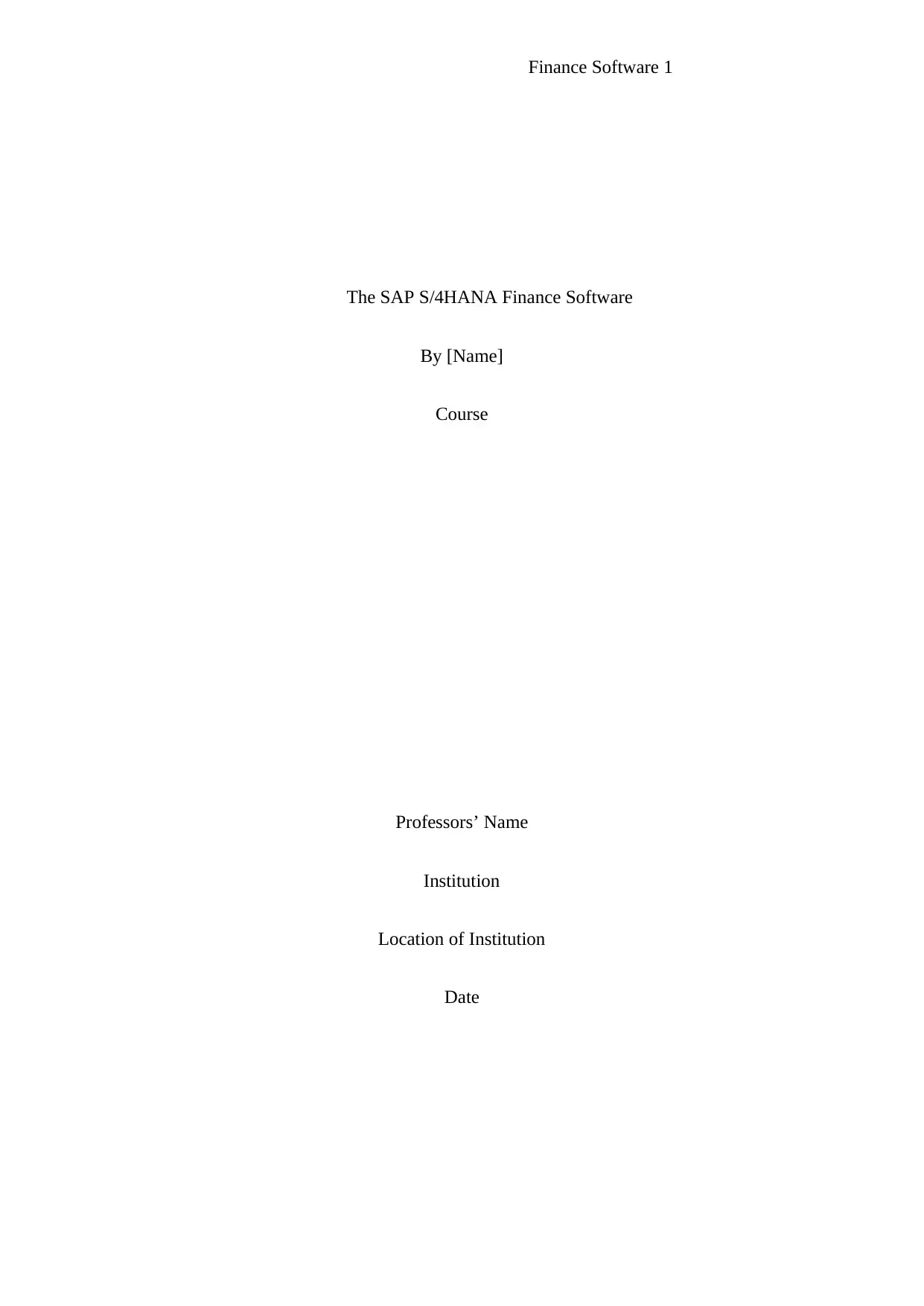
Finance Software 1
The SAP S/4HANA Finance Software
By [Name]
Course
Professors’ Name
Institution
Location of Institution
Date
The SAP S/4HANA Finance Software
By [Name]
Course
Professors’ Name
Institution
Location of Institution
Date
Secure Best Marks with AI Grader
Need help grading? Try our AI Grader for instant feedback on your assignments.
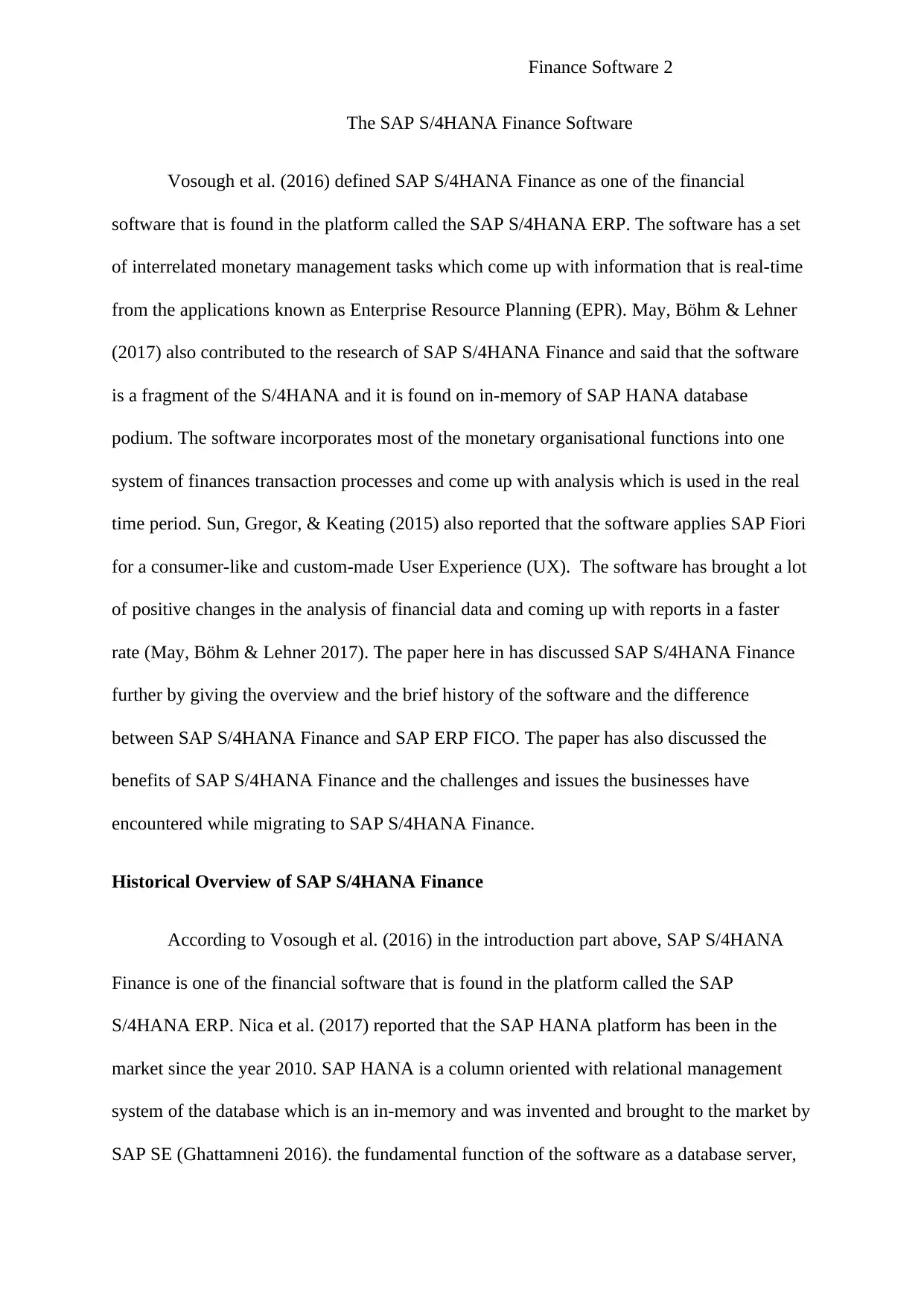
Finance Software 2
The SAP S/4HANA Finance Software
Vosough et al. (2016) defined SAP S/4HANA Finance as one of the financial
software that is found in the platform called the SAP S/4HANA ERP. The software has a set
of interrelated monetary management tasks which come up with information that is real-time
from the applications known as Enterprise Resource Planning (EPR). May, Böhm & Lehner
(2017) also contributed to the research of SAP S/4HANA Finance and said that the software
is a fragment of the S/4HANA and it is found on in-memory of SAP HANA database
podium. The software incorporates most of the monetary organisational functions into one
system of finances transaction processes and come up with analysis which is used in the real
time period. Sun, Gregor, & Keating (2015) also reported that the software applies SAP Fiori
for a consumer-like and custom-made User Experience (UX). The software has brought a lot
of positive changes in the analysis of financial data and coming up with reports in a faster
rate (May, Böhm & Lehner 2017) . The paper here in has discussed SAP S/4HANA Finance
further by giving the overview and the brief history of the software and the difference
between SAP S/4HANA Finance and SAP ERP FICO. The paper has also discussed the
benefits of SAP S/4HANA Finance and the challenges and issues the businesses have
encountered while migrating to SAP S/4HANA Finance.
Historical Overview of SAP S/4HANA Finance
According to Vosough et al. (2016) in the introduction part above, SAP S/4HANA
Finance is one of the financial software that is found in the platform called the SAP
S/4HANA ERP. Nica et al. (2017) reported that the SAP HANA platform has been in the
market since the year 2010. SAP HANA is a column oriented with relational management
system of the database which is an in-memory and was invented and brought to the market by
SAP SE (Ghattamneni 2016). the fundamental function of the software as a database server,
The SAP S/4HANA Finance Software
Vosough et al. (2016) defined SAP S/4HANA Finance as one of the financial
software that is found in the platform called the SAP S/4HANA ERP. The software has a set
of interrelated monetary management tasks which come up with information that is real-time
from the applications known as Enterprise Resource Planning (EPR). May, Böhm & Lehner
(2017) also contributed to the research of SAP S/4HANA Finance and said that the software
is a fragment of the S/4HANA and it is found on in-memory of SAP HANA database
podium. The software incorporates most of the monetary organisational functions into one
system of finances transaction processes and come up with analysis which is used in the real
time period. Sun, Gregor, & Keating (2015) also reported that the software applies SAP Fiori
for a consumer-like and custom-made User Experience (UX). The software has brought a lot
of positive changes in the analysis of financial data and coming up with reports in a faster
rate (May, Böhm & Lehner 2017) . The paper here in has discussed SAP S/4HANA Finance
further by giving the overview and the brief history of the software and the difference
between SAP S/4HANA Finance and SAP ERP FICO. The paper has also discussed the
benefits of SAP S/4HANA Finance and the challenges and issues the businesses have
encountered while migrating to SAP S/4HANA Finance.
Historical Overview of SAP S/4HANA Finance
According to Vosough et al. (2016) in the introduction part above, SAP S/4HANA
Finance is one of the financial software that is found in the platform called the SAP
S/4HANA ERP. Nica et al. (2017) reported that the SAP HANA platform has been in the
market since the year 2010. SAP HANA is a column oriented with relational management
system of the database which is an in-memory and was invented and brought to the market by
SAP SE (Ghattamneni 2016). the fundamental function of the software as a database server,
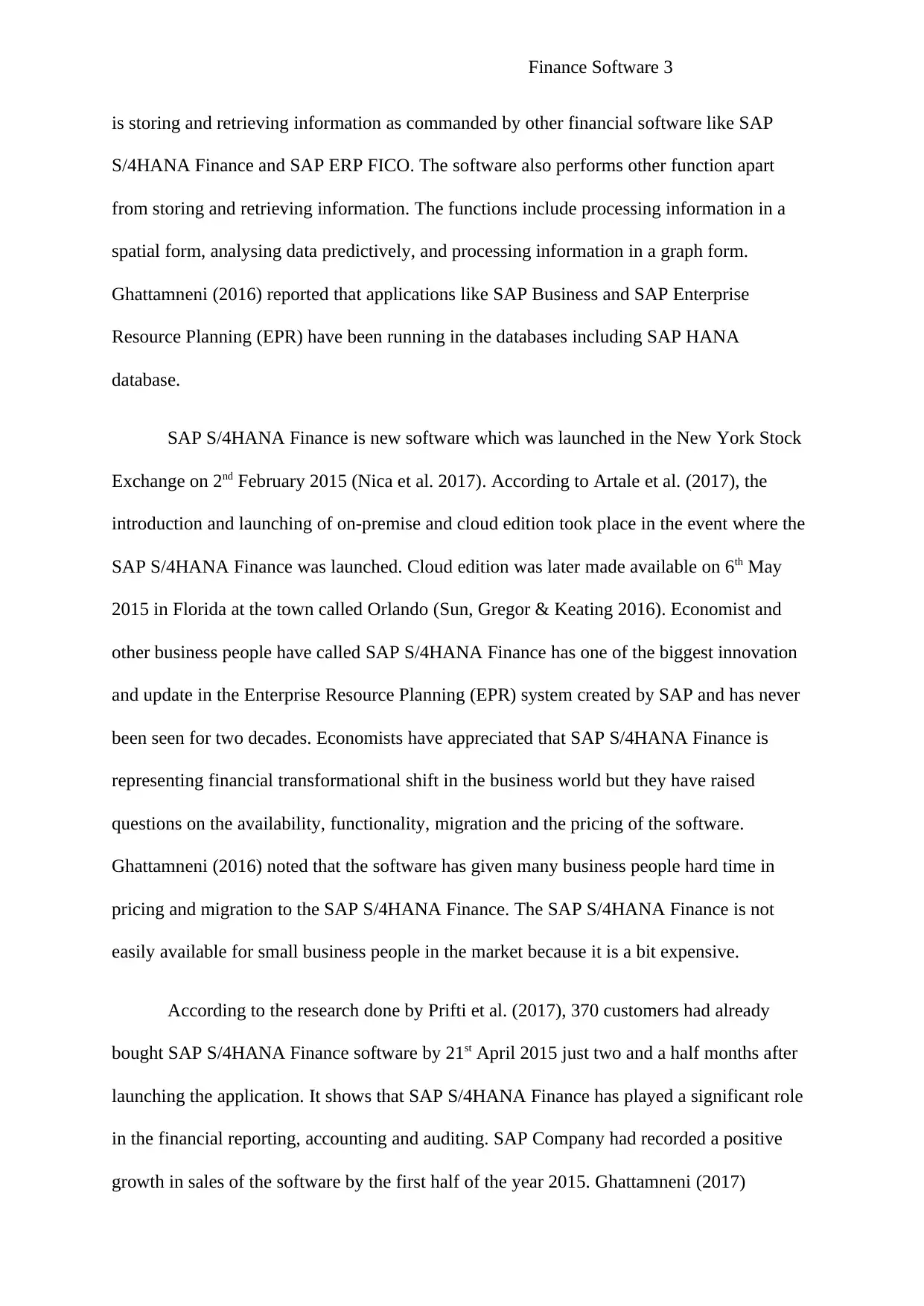
Finance Software 3
is storing and retrieving information as commanded by other financial software like SAP
S/4HANA Finance and SAP ERP FICO. The software also performs other function apart
from storing and retrieving information. The functions include processing information in a
spatial form, analysing data predictively, and processing information in a graph form.
Ghattamneni (2016) reported that applications like SAP Business and SAP Enterprise
Resource Planning (EPR) have been running in the databases including SAP HANA
database.
SAP S/4HANA Finance is new software which was launched in the New York Stock
Exchange on 2nd February 2015 (Nica et al. 2017). According to Artale et al. (2017), the
introduction and launching of on-premise and cloud edition took place in the event where the
SAP S/4HANA Finance was launched. Cloud edition was later made available on 6th May
2015 in Florida at the town called Orlando (Sun, Gregor & Keating 2016). Economist and
other business people have called SAP S/4HANA Finance has one of the biggest innovation
and update in the Enterprise Resource Planning (EPR) system created by SAP and has never
been seen for two decades. Economists have appreciated that SAP S/4HANA Finance is
representing financial transformational shift in the business world but they have raised
questions on the availability, functionality, migration and the pricing of the software.
Ghattamneni (2016) noted that the software has given many business people hard time in
pricing and migration to the SAP S/4HANA Finance. The SAP S/4HANA Finance is not
easily available for small business people in the market because it is a bit expensive.
According to the research done by Prifti et al. (2017), 370 customers had already
bought SAP S/4HANA Finance software by 21st April 2015 just two and a half months after
launching the application. It shows that SAP S/4HANA Finance has played a significant role
in the financial reporting, accounting and auditing. SAP Company had recorded a positive
growth in sales of the software by the first half of the year 2015. Ghattamneni (2017)
is storing and retrieving information as commanded by other financial software like SAP
S/4HANA Finance and SAP ERP FICO. The software also performs other function apart
from storing and retrieving information. The functions include processing information in a
spatial form, analysing data predictively, and processing information in a graph form.
Ghattamneni (2016) reported that applications like SAP Business and SAP Enterprise
Resource Planning (EPR) have been running in the databases including SAP HANA
database.
SAP S/4HANA Finance is new software which was launched in the New York Stock
Exchange on 2nd February 2015 (Nica et al. 2017). According to Artale et al. (2017), the
introduction and launching of on-premise and cloud edition took place in the event where the
SAP S/4HANA Finance was launched. Cloud edition was later made available on 6th May
2015 in Florida at the town called Orlando (Sun, Gregor & Keating 2016). Economist and
other business people have called SAP S/4HANA Finance has one of the biggest innovation
and update in the Enterprise Resource Planning (EPR) system created by SAP and has never
been seen for two decades. Economists have appreciated that SAP S/4HANA Finance is
representing financial transformational shift in the business world but they have raised
questions on the availability, functionality, migration and the pricing of the software.
Ghattamneni (2016) noted that the software has given many business people hard time in
pricing and migration to the SAP S/4HANA Finance. The SAP S/4HANA Finance is not
easily available for small business people in the market because it is a bit expensive.
According to the research done by Prifti et al. (2017), 370 customers had already
bought SAP S/4HANA Finance software by 21st April 2015 just two and a half months after
launching the application. It shows that SAP S/4HANA Finance has played a significant role
in the financial reporting, accounting and auditing. SAP Company had recorded a positive
growth in sales of the software by the first half of the year 2015. Ghattamneni (2017)
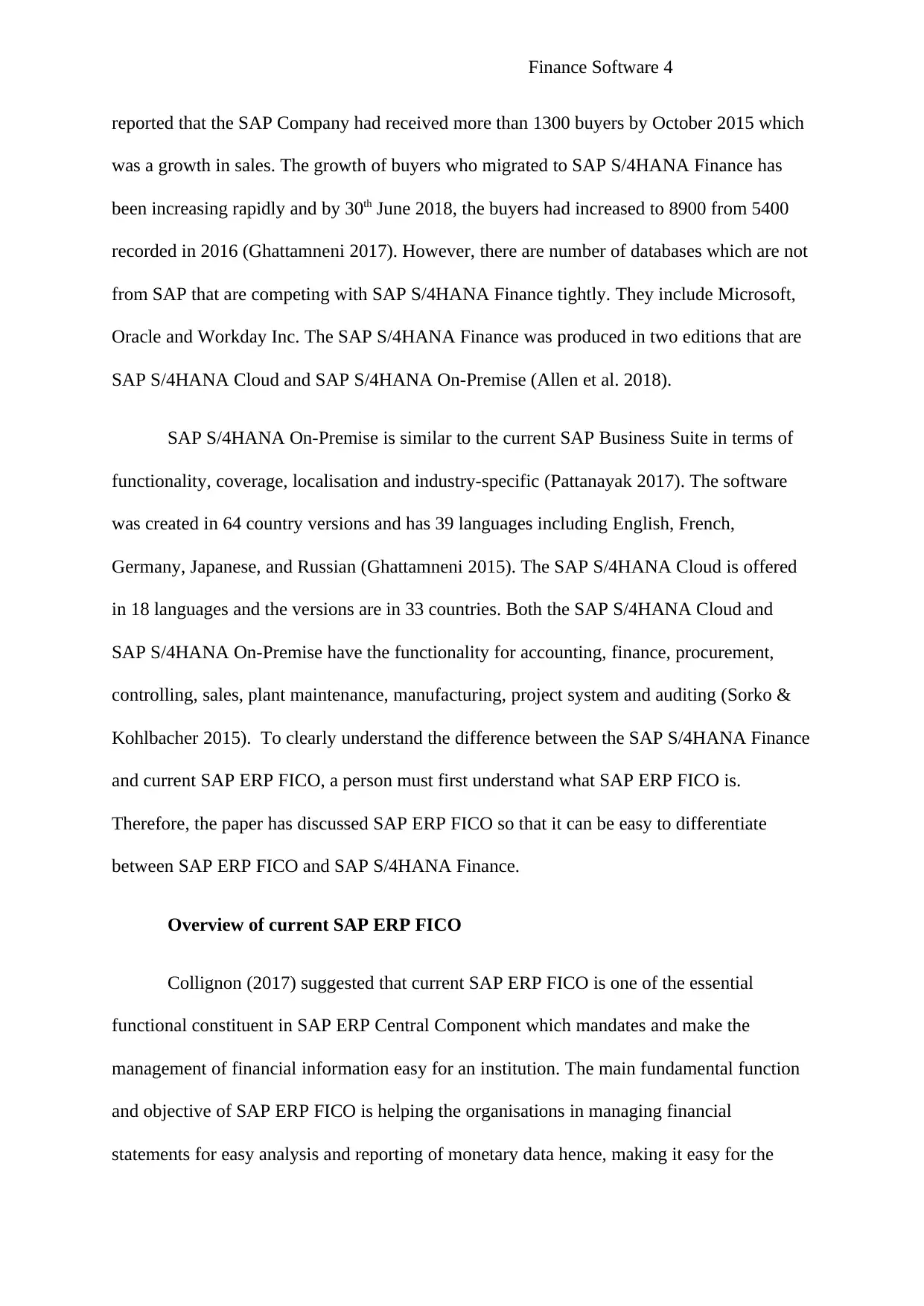
Finance Software 4
reported that the SAP Company had received more than 1300 buyers by October 2015 which
was a growth in sales. The growth of buyers who migrated to SAP S/4HANA Finance has
been increasing rapidly and by 30th June 2018, the buyers had increased to 8900 from 5400
recorded in 2016 (Ghattamneni 2017). However, there are number of databases which are not
from SAP that are competing with SAP S/4HANA Finance tightly. They include Microsoft,
Oracle and Workday Inc. The SAP S/4HANA Finance was produced in two editions that are
SAP S/4HANA Cloud and SAP S/4HANA On-Premise (Allen et al. 2018).
SAP S/4HANA On-Premise is similar to the current SAP Business Suite in terms of
functionality, coverage, localisation and industry-specific (Pattanayak 2017). The software
was created in 64 country versions and has 39 languages including English, French,
Germany, Japanese, and Russian (Ghattamneni 2015). The SAP S/4HANA Cloud is offered
in 18 languages and the versions are in 33 countries. Both the SAP S/4HANA Cloud and
SAP S/4HANA On-Premise have the functionality for accounting, finance, procurement,
controlling, sales, plant maintenance, manufacturing, project system and auditing (Sorko &
Kohlbacher 2015). To clearly understand the difference between the SAP S/4HANA Finance
and current SAP ERP FICO, a person must first understand what SAP ERP FICO is.
Therefore, the paper has discussed SAP ERP FICO so that it can be easy to differentiate
between SAP ERP FICO and SAP S/4HANA Finance.
Overview of current SAP ERP FICO
Collignon (2017) suggested that current SAP ERP FICO is one of the essential
functional constituent in SAP ERP Central Component which mandates and make the
management of financial information easy for an institution. The main fundamental function
and objective of SAP ERP FICO is helping the organisations in managing financial
statements for easy analysis and reporting of monetary data hence, making it easy for the
reported that the SAP Company had received more than 1300 buyers by October 2015 which
was a growth in sales. The growth of buyers who migrated to SAP S/4HANA Finance has
been increasing rapidly and by 30th June 2018, the buyers had increased to 8900 from 5400
recorded in 2016 (Ghattamneni 2017). However, there are number of databases which are not
from SAP that are competing with SAP S/4HANA Finance tightly. They include Microsoft,
Oracle and Workday Inc. The SAP S/4HANA Finance was produced in two editions that are
SAP S/4HANA Cloud and SAP S/4HANA On-Premise (Allen et al. 2018).
SAP S/4HANA On-Premise is similar to the current SAP Business Suite in terms of
functionality, coverage, localisation and industry-specific (Pattanayak 2017). The software
was created in 64 country versions and has 39 languages including English, French,
Germany, Japanese, and Russian (Ghattamneni 2015). The SAP S/4HANA Cloud is offered
in 18 languages and the versions are in 33 countries. Both the SAP S/4HANA Cloud and
SAP S/4HANA On-Premise have the functionality for accounting, finance, procurement,
controlling, sales, plant maintenance, manufacturing, project system and auditing (Sorko &
Kohlbacher 2015). To clearly understand the difference between the SAP S/4HANA Finance
and current SAP ERP FICO, a person must first understand what SAP ERP FICO is.
Therefore, the paper has discussed SAP ERP FICO so that it can be easy to differentiate
between SAP ERP FICO and SAP S/4HANA Finance.
Overview of current SAP ERP FICO
Collignon (2017) suggested that current SAP ERP FICO is one of the essential
functional constituent in SAP ERP Central Component which mandates and make the
management of financial information easy for an institution. The main fundamental function
and objective of SAP ERP FICO is helping the organisations in managing financial
statements for easy analysis and reporting of monetary data hence, making it easy for the
Secure Best Marks with AI Grader
Need help grading? Try our AI Grader for instant feedback on your assignments.
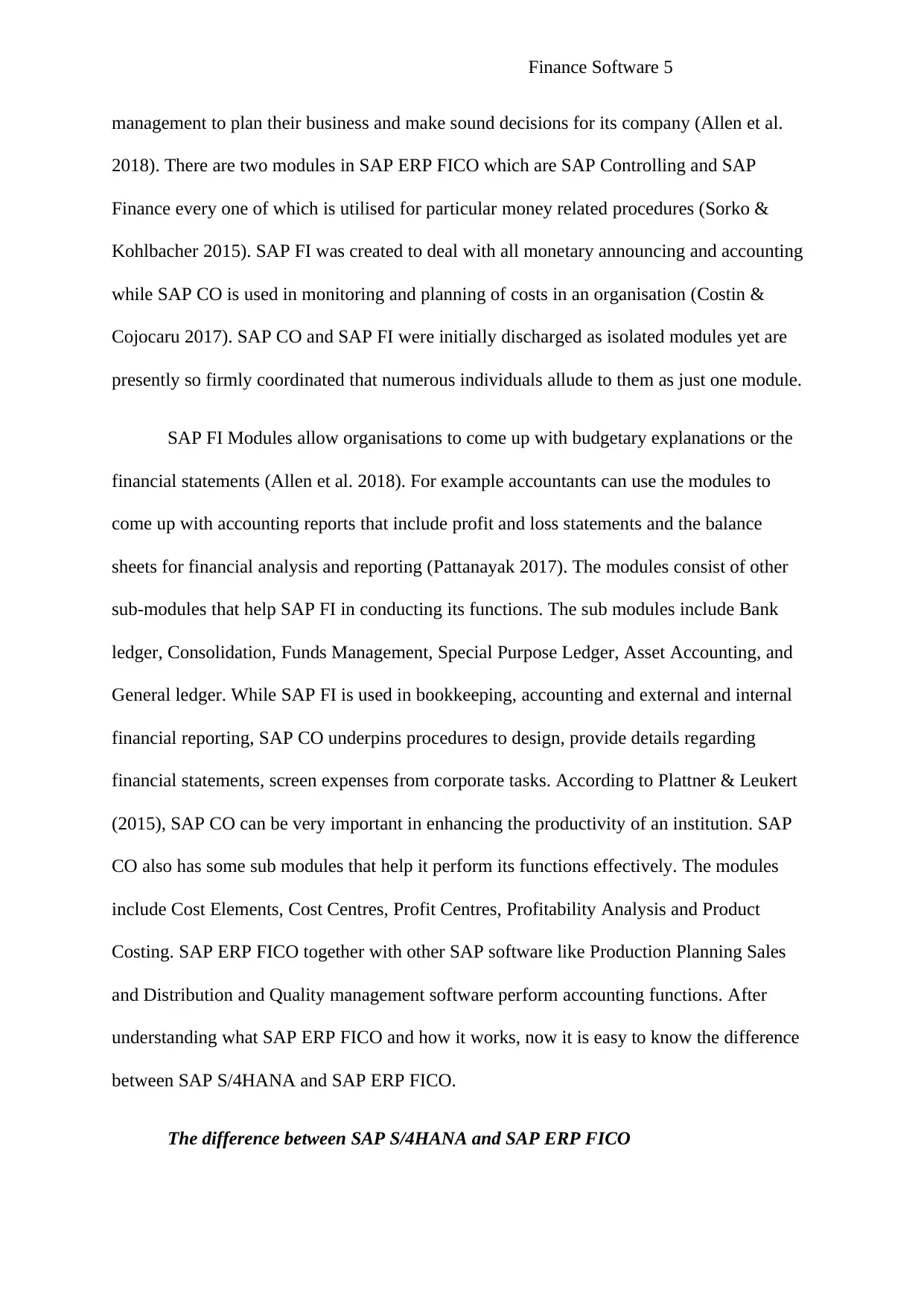
Finance Software 5
management to plan their business and make sound decisions for its company (Allen et al.
2018). There are two modules in SAP ERP FICO which are SAP Controlling and SAP
Finance every one of which is utilised for particular money related procedures (Sorko &
Kohlbacher 2015). SAP FI was created to deal with all monetary announcing and accounting
while SAP CO is used in monitoring and planning of costs in an organisation (Costin &
Cojocaru 2017). SAP CO and SAP FI were initially discharged as isolated modules yet are
presently so firmly coordinated that numerous individuals allude to them as just one module.
SAP FI Modules allow organisations to come up with budgetary explanations or the
financial statements (Allen et al. 2018). For example accountants can use the modules to
come up with accounting reports that include profit and loss statements and the balance
sheets for financial analysis and reporting (Pattanayak 2017). The modules consist of other
sub-modules that help SAP FI in conducting its functions. The sub modules include Bank
ledger, Consolidation, Funds Management, Special Purpose Ledger, Asset Accounting, and
General ledger. While SAP FI is used in bookkeeping, accounting and external and internal
financial reporting, SAP CO underpins procedures to design, provide details regarding
financial statements, screen expenses from corporate tasks. According to Plattner & Leukert
(2015), SAP CO can be very important in enhancing the productivity of an institution. SAP
CO also has some sub modules that help it perform its functions effectively. The modules
include Cost Elements, Cost Centres, Profit Centres, Profitability Analysis and Product
Costing. SAP ERP FICO together with other SAP software like Production Planning Sales
and Distribution and Quality management software perform accounting functions. After
understanding what SAP ERP FICO and how it works, now it is easy to know the difference
between SAP S/4HANA and SAP ERP FICO.
The difference between SAP S/4HANA and SAP ERP FICO
management to plan their business and make sound decisions for its company (Allen et al.
2018). There are two modules in SAP ERP FICO which are SAP Controlling and SAP
Finance every one of which is utilised for particular money related procedures (Sorko &
Kohlbacher 2015). SAP FI was created to deal with all monetary announcing and accounting
while SAP CO is used in monitoring and planning of costs in an organisation (Costin &
Cojocaru 2017). SAP CO and SAP FI were initially discharged as isolated modules yet are
presently so firmly coordinated that numerous individuals allude to them as just one module.
SAP FI Modules allow organisations to come up with budgetary explanations or the
financial statements (Allen et al. 2018). For example accountants can use the modules to
come up with accounting reports that include profit and loss statements and the balance
sheets for financial analysis and reporting (Pattanayak 2017). The modules consist of other
sub-modules that help SAP FI in conducting its functions. The sub modules include Bank
ledger, Consolidation, Funds Management, Special Purpose Ledger, Asset Accounting, and
General ledger. While SAP FI is used in bookkeeping, accounting and external and internal
financial reporting, SAP CO underpins procedures to design, provide details regarding
financial statements, screen expenses from corporate tasks. According to Plattner & Leukert
(2015), SAP CO can be very important in enhancing the productivity of an institution. SAP
CO also has some sub modules that help it perform its functions effectively. The modules
include Cost Elements, Cost Centres, Profit Centres, Profitability Analysis and Product
Costing. SAP ERP FICO together with other SAP software like Production Planning Sales
and Distribution and Quality management software perform accounting functions. After
understanding what SAP ERP FICO and how it works, now it is easy to know the difference
between SAP S/4HANA and SAP ERP FICO.
The difference between SAP S/4HANA and SAP ERP FICO
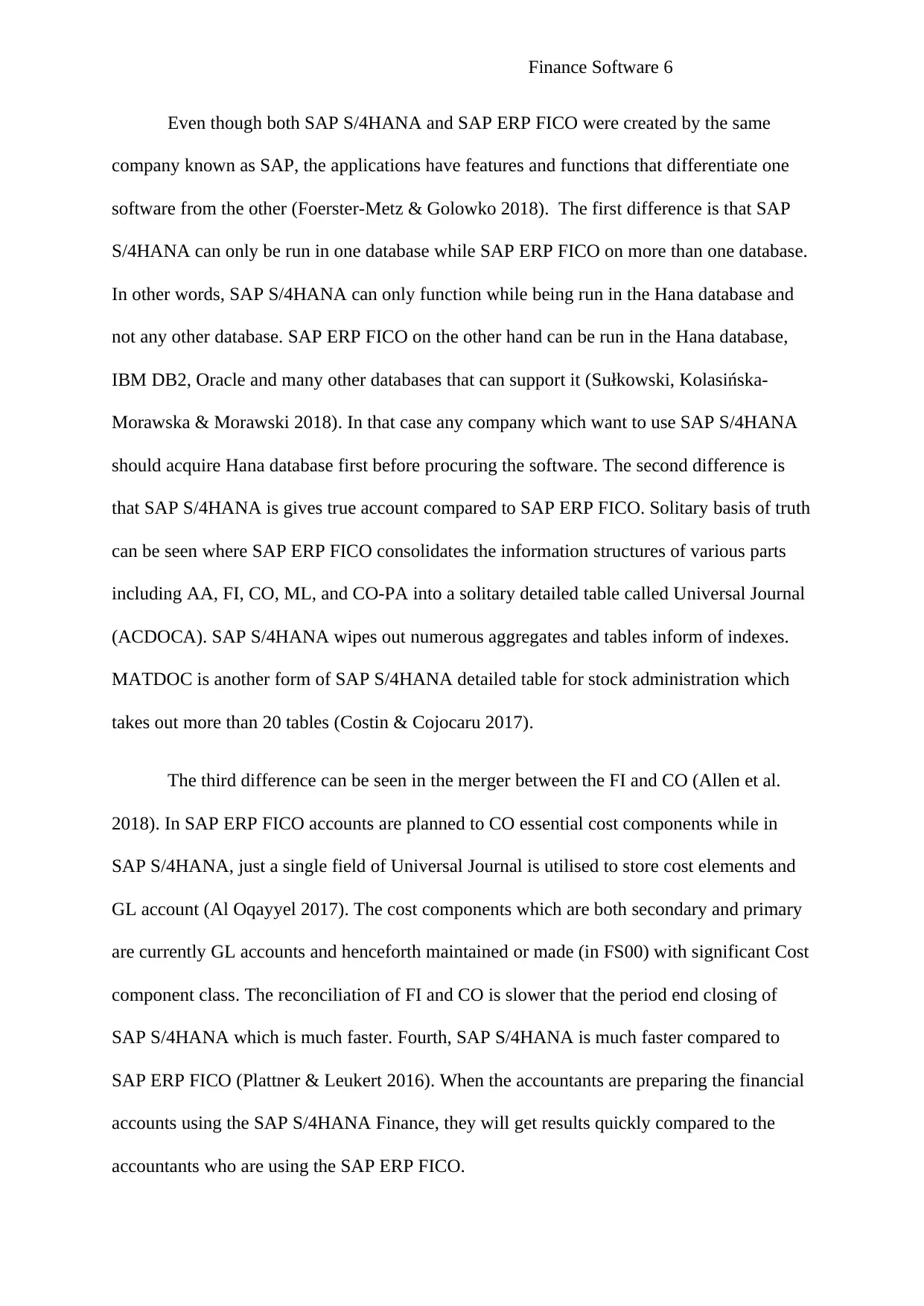
Finance Software 6
Even though both SAP S/4HANA and SAP ERP FICO were created by the same
company known as SAP, the applications have features and functions that differentiate one
software from the other (Foerster-Metz & Golowko 2018). The first difference is that SAP
S/4HANA can only be run in one database while SAP ERP FICO on more than one database.
In other words, SAP S/4HANA can only function while being run in the Hana database and
not any other database. SAP ERP FICO on the other hand can be run in the Hana database,
IBM DB2, Oracle and many other databases that can support it (Sułkowski, Kolasińska-
Morawska & Morawski 2018). In that case any company which want to use SAP S/4HANA
should acquire Hana database first before procuring the software. The second difference is
that SAP S/4HANA is gives true account compared to SAP ERP FICO. Solitary basis of truth
can be seen where SAP ERP FICO consolidates the information structures of various parts
including AA, FI, CO, ML, and CO-PA into a solitary detailed table called Universal Journal
(ACDOCA). SAP S/4HANA wipes out numerous aggregates and tables inform of indexes.
MATDOC is another form of SAP S/4HANA detailed table for stock administration which
takes out more than 20 tables (Costin & Cojocaru 2017).
The third difference can be seen in the merger between the FI and CO (Allen et al.
2018). In SAP ERP FICO accounts are planned to CO essential cost components while in
SAP S/4HANA, just a single field of Universal Journal is utilised to store cost elements and
GL account (Al Oqayyel 2017). The cost components which are both secondary and primary
are currently GL accounts and henceforth maintained or made (in FS00) with significant Cost
component class. The reconciliation of FI and CO is slower that the period end closing of
SAP S/4HANA which is much faster. Fourth, SAP S/4HANA is much faster compared to
SAP ERP FICO (Plattner & Leukert 2016). When the accountants are preparing the financial
accounts using the SAP S/4HANA Finance, they will get results quickly compared to the
accountants who are using the SAP ERP FICO.
Even though both SAP S/4HANA and SAP ERP FICO were created by the same
company known as SAP, the applications have features and functions that differentiate one
software from the other (Foerster-Metz & Golowko 2018). The first difference is that SAP
S/4HANA can only be run in one database while SAP ERP FICO on more than one database.
In other words, SAP S/4HANA can only function while being run in the Hana database and
not any other database. SAP ERP FICO on the other hand can be run in the Hana database,
IBM DB2, Oracle and many other databases that can support it (Sułkowski, Kolasińska-
Morawska & Morawski 2018). In that case any company which want to use SAP S/4HANA
should acquire Hana database first before procuring the software. The second difference is
that SAP S/4HANA is gives true account compared to SAP ERP FICO. Solitary basis of truth
can be seen where SAP ERP FICO consolidates the information structures of various parts
including AA, FI, CO, ML, and CO-PA into a solitary detailed table called Universal Journal
(ACDOCA). SAP S/4HANA wipes out numerous aggregates and tables inform of indexes.
MATDOC is another form of SAP S/4HANA detailed table for stock administration which
takes out more than 20 tables (Costin & Cojocaru 2017).
The third difference can be seen in the merger between the FI and CO (Allen et al.
2018). In SAP ERP FICO accounts are planned to CO essential cost components while in
SAP S/4HANA, just a single field of Universal Journal is utilised to store cost elements and
GL account (Al Oqayyel 2017). The cost components which are both secondary and primary
are currently GL accounts and henceforth maintained or made (in FS00) with significant Cost
component class. The reconciliation of FI and CO is slower that the period end closing of
SAP S/4HANA which is much faster. Fourth, SAP S/4HANA is much faster compared to
SAP ERP FICO (Plattner & Leukert 2016). When the accountants are preparing the financial
accounts using the SAP S/4HANA Finance, they will get results quickly compared to the
accountants who are using the SAP ERP FICO.
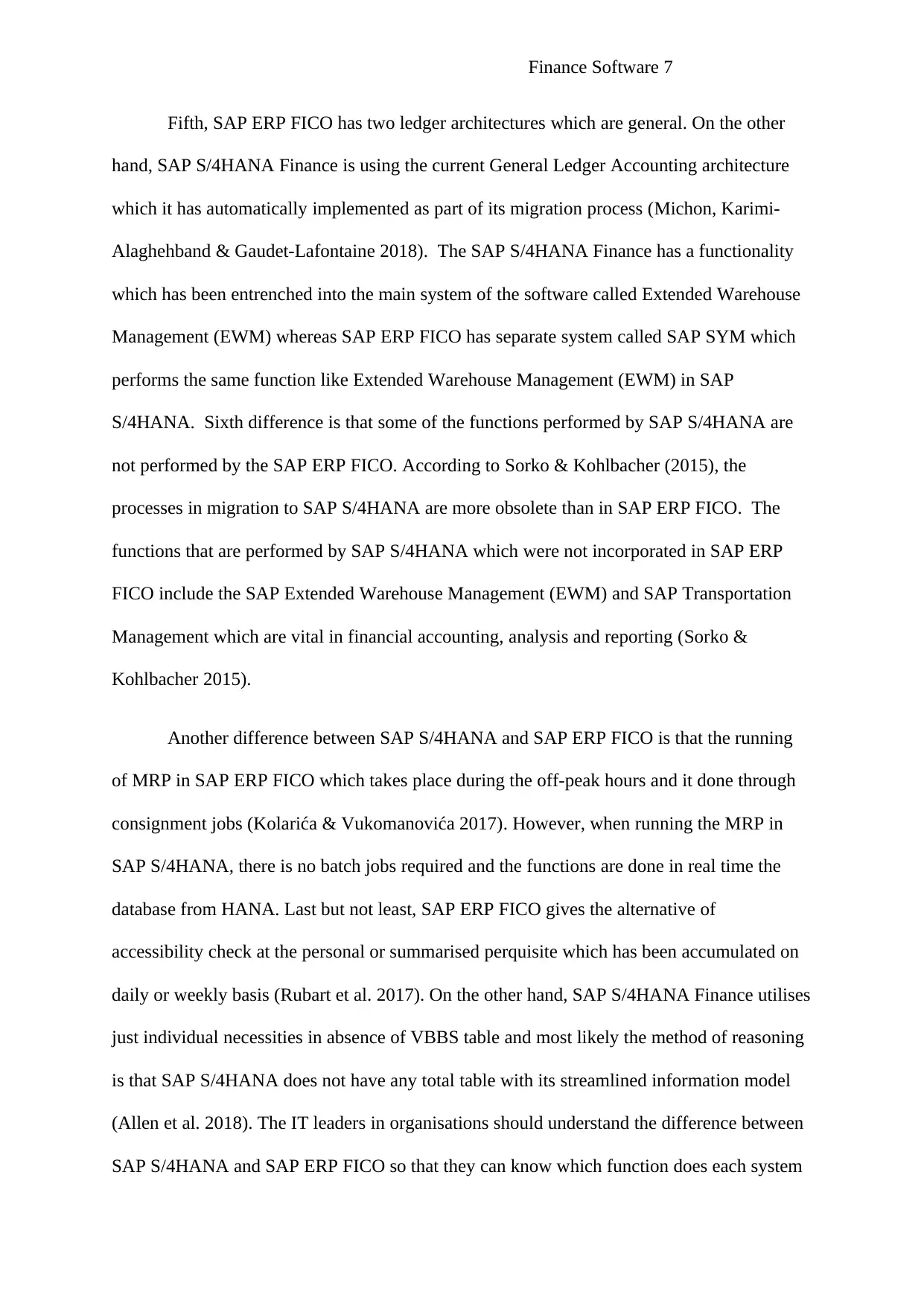
Finance Software 7
Fifth, SAP ERP FICO has two ledger architectures which are general. On the other
hand, SAP S/4HANA Finance is using the current General Ledger Accounting architecture
which it has automatically implemented as part of its migration process (Michon, Karimi-
Alaghehband & Gaudet-Lafontaine 2018). The SAP S/4HANA Finance has a functionality
which has been entrenched into the main system of the software called Extended Warehouse
Management (EWM) whereas SAP ERP FICO has separate system called SAP SYM which
performs the same function like Extended Warehouse Management (EWM) in SAP
S/4HANA. Sixth difference is that some of the functions performed by SAP S/4HANA are
not performed by the SAP ERP FICO. According to Sorko & Kohlbacher (2015), the
processes in migration to SAP S/4HANA are more obsolete than in SAP ERP FICO. The
functions that are performed by SAP S/4HANA which were not incorporated in SAP ERP
FICO include the SAP Extended Warehouse Management (EWM) and SAP Transportation
Management which are vital in financial accounting, analysis and reporting (Sorko &
Kohlbacher 2015).
Another difference between SAP S/4HANA and SAP ERP FICO is that the running
of MRP in SAP ERP FICO which takes place during the off-peak hours and it done through
consignment jobs (Kolarića & Vukomanovića 2017). However, when running the MRP in
SAP S/4HANA, there is no batch jobs required and the functions are done in real time the
database from HANA. Last but not least, SAP ERP FICO gives the alternative of
accessibility check at the personal or summarised perquisite which has been accumulated on
daily or weekly basis (Rubart et al. 2017). On the other hand, SAP S/4HANA Finance utilises
just individual necessities in absence of VBBS table and most likely the method of reasoning
is that SAP S/4HANA does not have any total table with its streamlined information model
(Allen et al. 2018). The IT leaders in organisations should understand the difference between
SAP S/4HANA and SAP ERP FICO so that they can know which function does each system
Fifth, SAP ERP FICO has two ledger architectures which are general. On the other
hand, SAP S/4HANA Finance is using the current General Ledger Accounting architecture
which it has automatically implemented as part of its migration process (Michon, Karimi-
Alaghehband & Gaudet-Lafontaine 2018). The SAP S/4HANA Finance has a functionality
which has been entrenched into the main system of the software called Extended Warehouse
Management (EWM) whereas SAP ERP FICO has separate system called SAP SYM which
performs the same function like Extended Warehouse Management (EWM) in SAP
S/4HANA. Sixth difference is that some of the functions performed by SAP S/4HANA are
not performed by the SAP ERP FICO. According to Sorko & Kohlbacher (2015), the
processes in migration to SAP S/4HANA are more obsolete than in SAP ERP FICO. The
functions that are performed by SAP S/4HANA which were not incorporated in SAP ERP
FICO include the SAP Extended Warehouse Management (EWM) and SAP Transportation
Management which are vital in financial accounting, analysis and reporting (Sorko &
Kohlbacher 2015).
Another difference between SAP S/4HANA and SAP ERP FICO is that the running
of MRP in SAP ERP FICO which takes place during the off-peak hours and it done through
consignment jobs (Kolarića & Vukomanovića 2017). However, when running the MRP in
SAP S/4HANA, there is no batch jobs required and the functions are done in real time the
database from HANA. Last but not least, SAP ERP FICO gives the alternative of
accessibility check at the personal or summarised perquisite which has been accumulated on
daily or weekly basis (Rubart et al. 2017). On the other hand, SAP S/4HANA Finance utilises
just individual necessities in absence of VBBS table and most likely the method of reasoning
is that SAP S/4HANA does not have any total table with its streamlined information model
(Allen et al. 2018). The IT leaders in organisations should understand the difference between
SAP S/4HANA and SAP ERP FICO so that they can know which function does each system
Paraphrase This Document
Need a fresh take? Get an instant paraphrase of this document with our AI Paraphraser
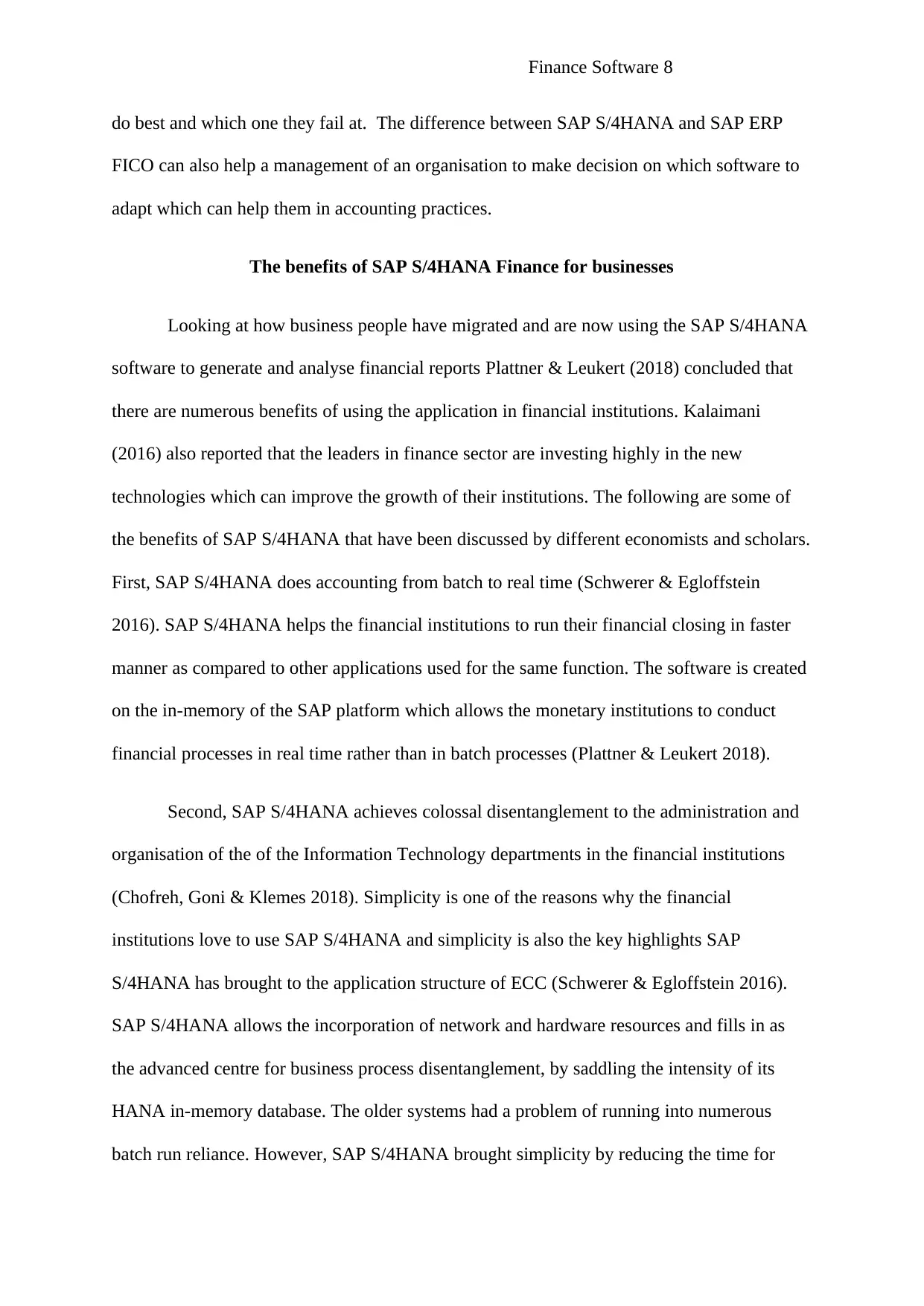
Finance Software 8
do best and which one they fail at. The difference between SAP S/4HANA and SAP ERP
FICO can also help a management of an organisation to make decision on which software to
adapt which can help them in accounting practices.
The benefits of SAP S/4HANA Finance for businesses
Looking at how business people have migrated and are now using the SAP S/4HANA
software to generate and analyse financial reports Plattner & Leukert (2018) concluded that
there are numerous benefits of using the application in financial institutions. Kalaimani
(2016) also reported that the leaders in finance sector are investing highly in the new
technologies which can improve the growth of their institutions. The following are some of
the benefits of SAP S/4HANA that have been discussed by different economists and scholars.
First, SAP S/4HANA does accounting from batch to real time (Schwerer & Egloffstein
2016). SAP S/4HANA helps the financial institutions to run their financial closing in faster
manner as compared to other applications used for the same function. The software is created
on the in-memory of the SAP platform which allows the monetary institutions to conduct
financial processes in real time rather than in batch processes (Plattner & Leukert 2018).
Second, SAP S/4HANA achieves colossal disentanglement to the administration and
organisation of the of the Information Technology departments in the financial institutions
(Chofreh, Goni & Klemes 2018). Simplicity is one of the reasons why the financial
institutions love to use SAP S/4HANA and simplicity is also the key highlights SAP
S/4HANA has brought to the application structure of ECC (Schwerer & Egloffstein 2016).
SAP S/4HANA allows the incorporation of network and hardware resources and fills in as
the advanced centre for business process disentanglement, by saddling the intensity of its
HANA in-memory database. The older systems had a problem of running into numerous
batch run reliance. However, SAP S/4HANA brought simplicity by reducing the time for
do best and which one they fail at. The difference between SAP S/4HANA and SAP ERP
FICO can also help a management of an organisation to make decision on which software to
adapt which can help them in accounting practices.
The benefits of SAP S/4HANA Finance for businesses
Looking at how business people have migrated and are now using the SAP S/4HANA
software to generate and analyse financial reports Plattner & Leukert (2018) concluded that
there are numerous benefits of using the application in financial institutions. Kalaimani
(2016) also reported that the leaders in finance sector are investing highly in the new
technologies which can improve the growth of their institutions. The following are some of
the benefits of SAP S/4HANA that have been discussed by different economists and scholars.
First, SAP S/4HANA does accounting from batch to real time (Schwerer & Egloffstein
2016). SAP S/4HANA helps the financial institutions to run their financial closing in faster
manner as compared to other applications used for the same function. The software is created
on the in-memory of the SAP platform which allows the monetary institutions to conduct
financial processes in real time rather than in batch processes (Plattner & Leukert 2018).
Second, SAP S/4HANA achieves colossal disentanglement to the administration and
organisation of the of the Information Technology departments in the financial institutions
(Chofreh, Goni & Klemes 2018). Simplicity is one of the reasons why the financial
institutions love to use SAP S/4HANA and simplicity is also the key highlights SAP
S/4HANA has brought to the application structure of ECC (Schwerer & Egloffstein 2016).
SAP S/4HANA allows the incorporation of network and hardware resources and fills in as
the advanced centre for business process disentanglement, by saddling the intensity of its
HANA in-memory database. The older systems had a problem of running into numerous
batch run reliance. However, SAP S/4HANA brought simplicity by reducing the time for
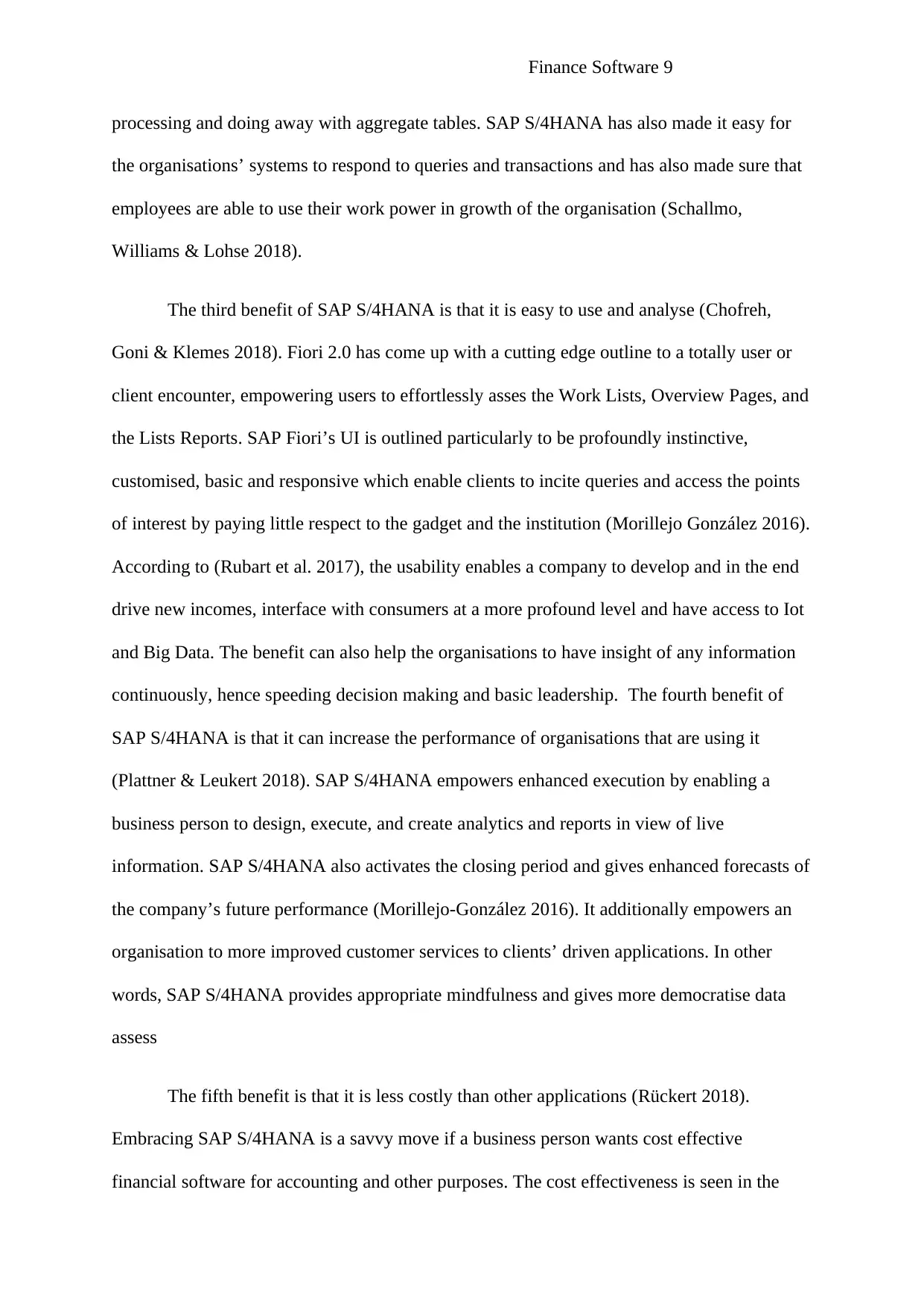
Finance Software 9
processing and doing away with aggregate tables. SAP S/4HANA has also made it easy for
the organisations’ systems to respond to queries and transactions and has also made sure that
employees are able to use their work power in growth of the organisation (Schallmo,
Williams & Lohse 2018).
The third benefit of SAP S/4HANA is that it is easy to use and analyse (Chofreh,
Goni & Klemes 2018). Fiori 2.0 has come up with a cutting edge outline to a totally user or
client encounter, empowering users to effortlessly asses the Work Lists, Overview Pages, and
the Lists Reports. SAP Fiori’s UI is outlined particularly to be profoundly instinctive,
customised, basic and responsive which enable clients to incite queries and access the points
of interest by paying little respect to the gadget and the institution (Morillejo González 2016).
According to (Rubart et al. 2017), the usability enables a company to develop and in the end
drive new incomes, interface with consumers at a more profound level and have access to Iot
and Big Data. The benefit can also help the organisations to have insight of any information
continuously, hence speeding decision making and basic leadership. The fourth benefit of
SAP S/4HANA is that it can increase the performance of organisations that are using it
(Plattner & Leukert 2018). SAP S/4HANA empowers enhanced execution by enabling a
business person to design, execute, and create analytics and reports in view of live
information. SAP S/4HANA also activates the closing period and gives enhanced forecasts of
the company’s future performance (Morillejo-González 2016). It additionally empowers an
organisation to more improved customer services to clients’ driven applications. In other
words, SAP S/4HANA provides appropriate mindfulness and gives more democratise data
assess
The fifth benefit is that it is less costly than other applications (Rückert 2018).
Embracing SAP S/4HANA is a savvy move if a business person wants cost effective
financial software for accounting and other purposes. The cost effectiveness is seen in the
processing and doing away with aggregate tables. SAP S/4HANA has also made it easy for
the organisations’ systems to respond to queries and transactions and has also made sure that
employees are able to use their work power in growth of the organisation (Schallmo,
Williams & Lohse 2018).
The third benefit of SAP S/4HANA is that it is easy to use and analyse (Chofreh,
Goni & Klemes 2018). Fiori 2.0 has come up with a cutting edge outline to a totally user or
client encounter, empowering users to effortlessly asses the Work Lists, Overview Pages, and
the Lists Reports. SAP Fiori’s UI is outlined particularly to be profoundly instinctive,
customised, basic and responsive which enable clients to incite queries and access the points
of interest by paying little respect to the gadget and the institution (Morillejo González 2016).
According to (Rubart et al. 2017), the usability enables a company to develop and in the end
drive new incomes, interface with consumers at a more profound level and have access to Iot
and Big Data. The benefit can also help the organisations to have insight of any information
continuously, hence speeding decision making and basic leadership. The fourth benefit of
SAP S/4HANA is that it can increase the performance of organisations that are using it
(Plattner & Leukert 2018). SAP S/4HANA empowers enhanced execution by enabling a
business person to design, execute, and create analytics and reports in view of live
information. SAP S/4HANA also activates the closing period and gives enhanced forecasts of
the company’s future performance (Morillejo-González 2016). It additionally empowers an
organisation to more improved customer services to clients’ driven applications. In other
words, SAP S/4HANA provides appropriate mindfulness and gives more democratise data
assess
The fifth benefit is that it is less costly than other applications (Rückert 2018).
Embracing SAP S/4HANA is a savvy move if a business person wants cost effective
financial software for accounting and other purposes. The cost effectiveness is seen in the
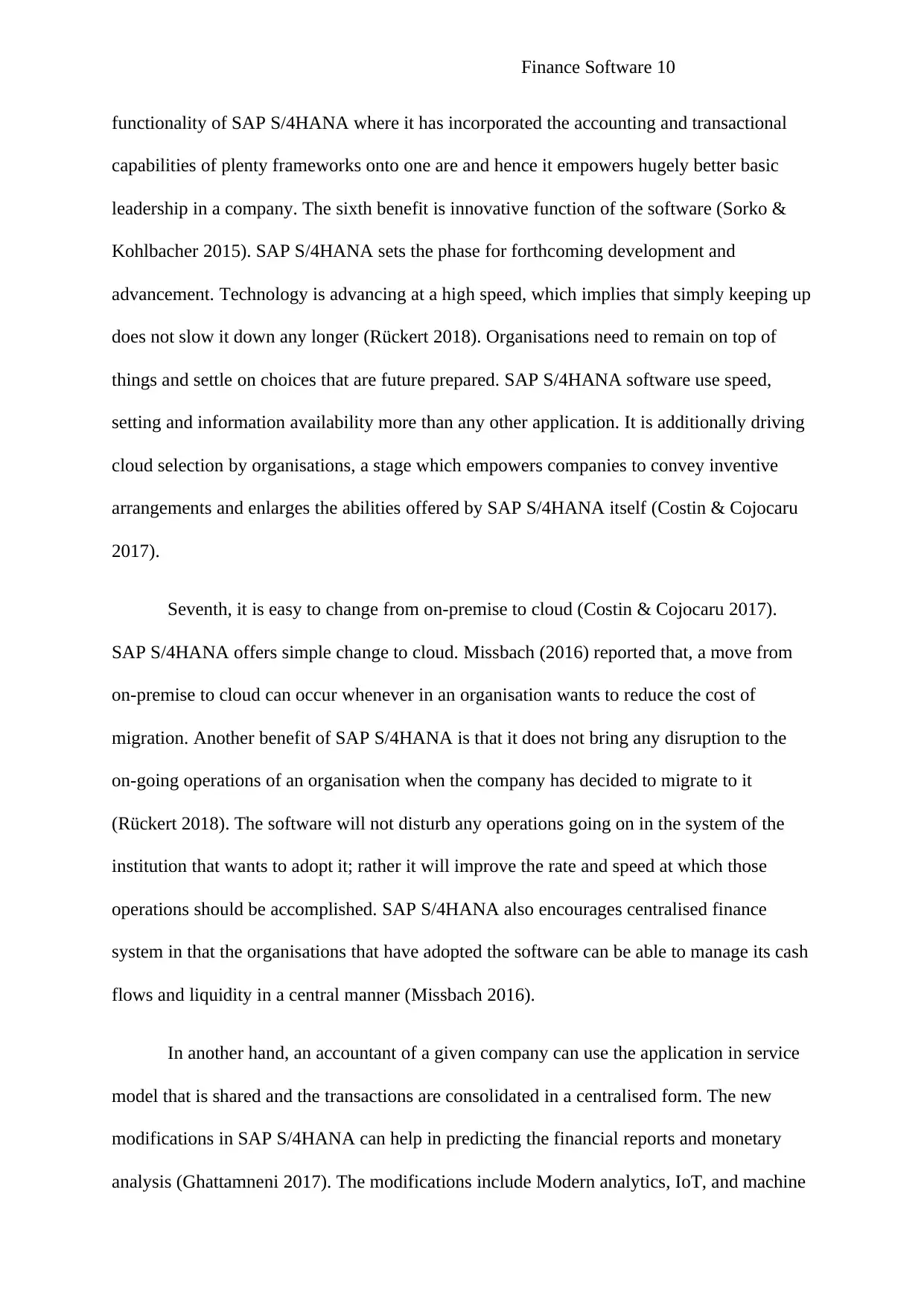
Finance Software 10
functionality of SAP S/4HANA where it has incorporated the accounting and transactional
capabilities of plenty frameworks onto one are and hence it empowers hugely better basic
leadership in a company. The sixth benefit is innovative function of the software (Sorko &
Kohlbacher 2015). SAP S/4HANA sets the phase for forthcoming development and
advancement. Technology is advancing at a high speed, which implies that simply keeping up
does not slow it down any longer (Rückert 2018). Organisations need to remain on top of
things and settle on choices that are future prepared. SAP S/4HANA software use speed,
setting and information availability more than any other application. It is additionally driving
cloud selection by organisations, a stage which empowers companies to convey inventive
arrangements and enlarges the abilities offered by SAP S/4HANA itself (Costin & Cojocaru
2017).
Seventh, it is easy to change from on-premise to cloud (Costin & Cojocaru 2017).
SAP S/4HANA offers simple change to cloud. Missbach (2016) reported that, a move from
on-premise to cloud can occur whenever in an organisation wants to reduce the cost of
migration. Another benefit of SAP S/4HANA is that it does not bring any disruption to the
on-going operations of an organisation when the company has decided to migrate to it
(Rückert 2018). The software will not disturb any operations going on in the system of the
institution that wants to adopt it; rather it will improve the rate and speed at which those
operations should be accomplished. SAP S/4HANA also encourages centralised finance
system in that the organisations that have adopted the software can be able to manage its cash
flows and liquidity in a central manner (Missbach 2016).
In another hand, an accountant of a given company can use the application in service
model that is shared and the transactions are consolidated in a centralised form. The new
modifications in SAP S/4HANA can help in predicting the financial reports and monetary
analysis (Ghattamneni 2017). The modifications include Modern analytics, IoT, and machine
functionality of SAP S/4HANA where it has incorporated the accounting and transactional
capabilities of plenty frameworks onto one are and hence it empowers hugely better basic
leadership in a company. The sixth benefit is innovative function of the software (Sorko &
Kohlbacher 2015). SAP S/4HANA sets the phase for forthcoming development and
advancement. Technology is advancing at a high speed, which implies that simply keeping up
does not slow it down any longer (Rückert 2018). Organisations need to remain on top of
things and settle on choices that are future prepared. SAP S/4HANA software use speed,
setting and information availability more than any other application. It is additionally driving
cloud selection by organisations, a stage which empowers companies to convey inventive
arrangements and enlarges the abilities offered by SAP S/4HANA itself (Costin & Cojocaru
2017).
Seventh, it is easy to change from on-premise to cloud (Costin & Cojocaru 2017).
SAP S/4HANA offers simple change to cloud. Missbach (2016) reported that, a move from
on-premise to cloud can occur whenever in an organisation wants to reduce the cost of
migration. Another benefit of SAP S/4HANA is that it does not bring any disruption to the
on-going operations of an organisation when the company has decided to migrate to it
(Rückert 2018). The software will not disturb any operations going on in the system of the
institution that wants to adopt it; rather it will improve the rate and speed at which those
operations should be accomplished. SAP S/4HANA also encourages centralised finance
system in that the organisations that have adopted the software can be able to manage its cash
flows and liquidity in a central manner (Missbach 2016).
In another hand, an accountant of a given company can use the application in service
model that is shared and the transactions are consolidated in a centralised form. The new
modifications in SAP S/4HANA can help in predicting the financial reports and monetary
analysis (Ghattamneni 2017). The modifications include Modern analytics, IoT, and machine
Secure Best Marks with AI Grader
Need help grading? Try our AI Grader for instant feedback on your assignments.
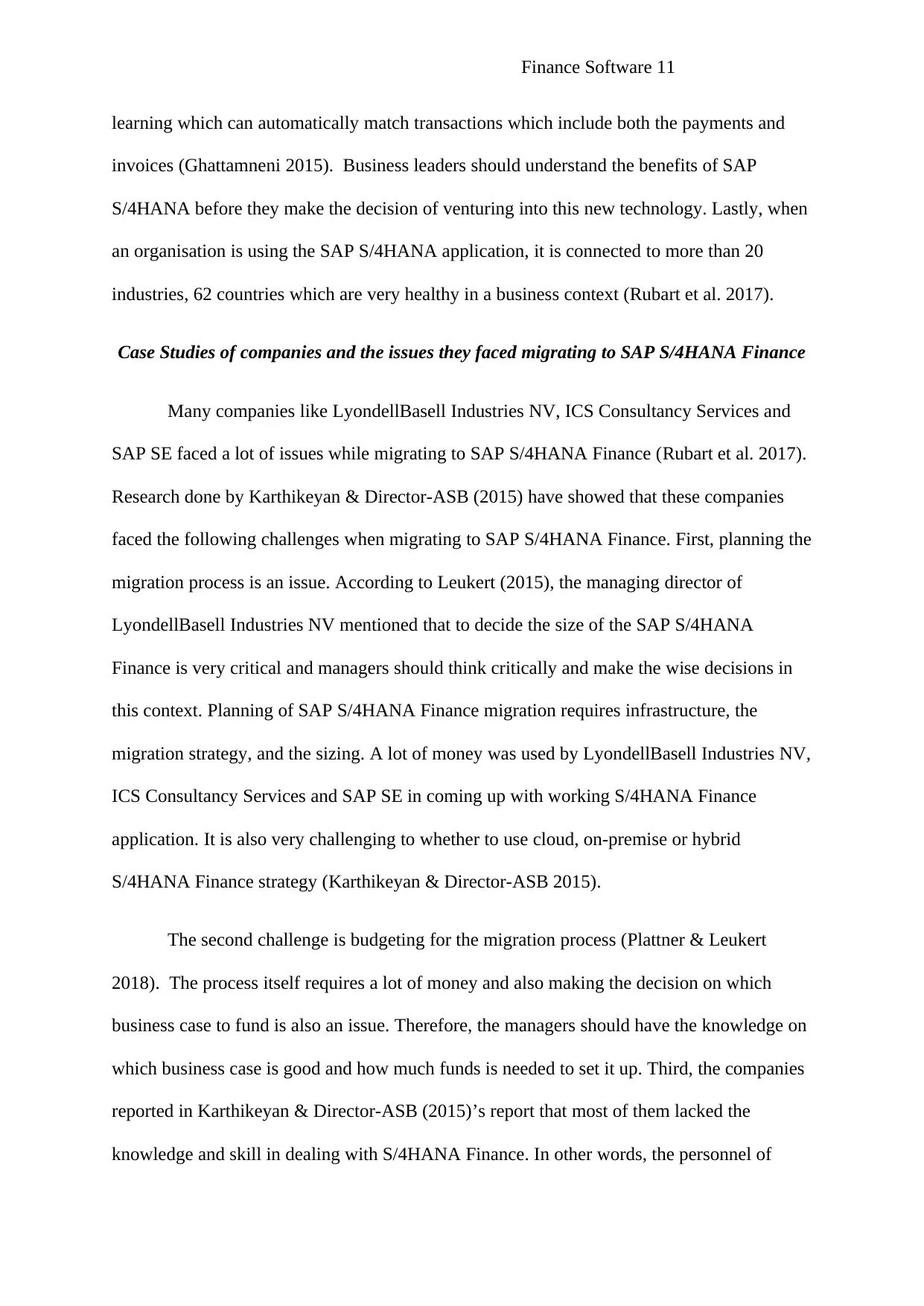
Finance Software 11
learning which can automatically match transactions which include both the payments and
invoices (Ghattamneni 2015). Business leaders should understand the benefits of SAP
S/4HANA before they make the decision of venturing into this new technology. Lastly, when
an organisation is using the SAP S/4HANA application, it is connected to more than 20
industries, 62 countries which are very healthy in a business context (Rubart et al. 2017).
Case Studies of companies and the issues they faced migrating to SAP S/4HANA Finance
Many companies like LyondellBasell Industries NV, ICS Consultancy Services and
SAP SE faced a lot of issues while migrating to SAP S/4HANA Finance (Rubart et al. 2017).
Research done by Karthikeyan & Director-ASB (2015) have showed that these companies
faced the following challenges when migrating to SAP S/4HANA Finance. First, planning the
migration process is an issue. According to Leukert (2015), the managing director of
LyondellBasell Industries NV mentioned that to decide the size of the SAP S/4HANA
Finance is very critical and managers should think critically and make the wise decisions in
this context. Planning of SAP S/4HANA Finance migration requires infrastructure, the
migration strategy, and the sizing. A lot of money was used by LyondellBasell Industries NV,
ICS Consultancy Services and SAP SE in coming up with working S/4HANA Finance
application. It is also very challenging to whether to use cloud, on-premise or hybrid
S/4HANA Finance strategy (Karthikeyan & Director-ASB 2015).
The second challenge is budgeting for the migration process (Plattner & Leukert
2018). The process itself requires a lot of money and also making the decision on which
business case to fund is also an issue. Therefore, the managers should have the knowledge on
which business case is good and how much funds is needed to set it up. Third, the companies
reported in Karthikeyan & Director-ASB (2015)’s report that most of them lacked the
knowledge and skill in dealing with S/4HANA Finance. In other words, the personnel of
learning which can automatically match transactions which include both the payments and
invoices (Ghattamneni 2015). Business leaders should understand the benefits of SAP
S/4HANA before they make the decision of venturing into this new technology. Lastly, when
an organisation is using the SAP S/4HANA application, it is connected to more than 20
industries, 62 countries which are very healthy in a business context (Rubart et al. 2017).
Case Studies of companies and the issues they faced migrating to SAP S/4HANA Finance
Many companies like LyondellBasell Industries NV, ICS Consultancy Services and
SAP SE faced a lot of issues while migrating to SAP S/4HANA Finance (Rubart et al. 2017).
Research done by Karthikeyan & Director-ASB (2015) have showed that these companies
faced the following challenges when migrating to SAP S/4HANA Finance. First, planning the
migration process is an issue. According to Leukert (2015), the managing director of
LyondellBasell Industries NV mentioned that to decide the size of the SAP S/4HANA
Finance is very critical and managers should think critically and make the wise decisions in
this context. Planning of SAP S/4HANA Finance migration requires infrastructure, the
migration strategy, and the sizing. A lot of money was used by LyondellBasell Industries NV,
ICS Consultancy Services and SAP SE in coming up with working S/4HANA Finance
application. It is also very challenging to whether to use cloud, on-premise or hybrid
S/4HANA Finance strategy (Karthikeyan & Director-ASB 2015).
The second challenge is budgeting for the migration process (Plattner & Leukert
2018). The process itself requires a lot of money and also making the decision on which
business case to fund is also an issue. Therefore, the managers should have the knowledge on
which business case is good and how much funds is needed to set it up. Third, the companies
reported in Karthikeyan & Director-ASB (2015)’s report that most of them lacked the
knowledge and skill in dealing with S/4HANA Finance. In other words, the personnel of
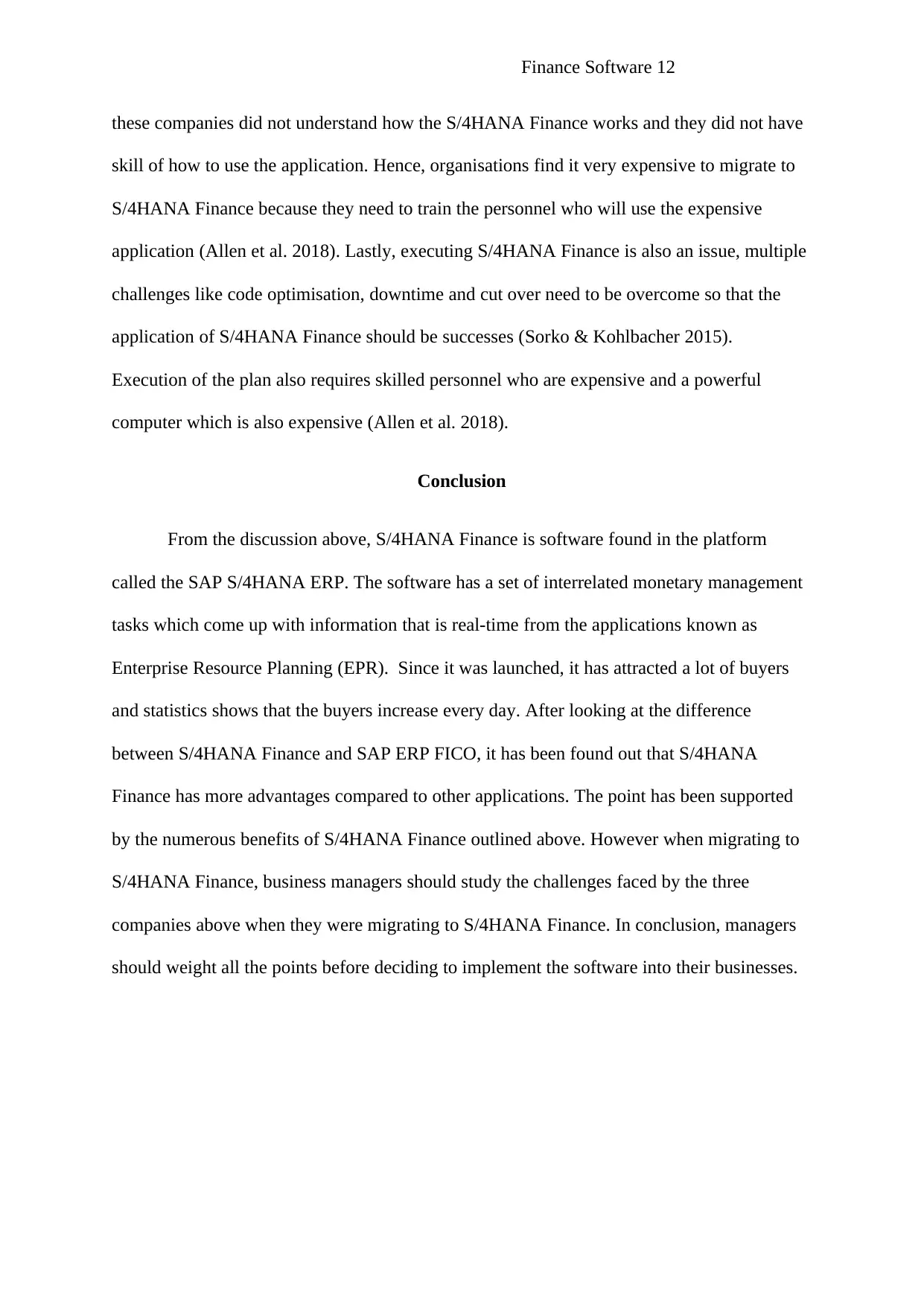
Finance Software 12
these companies did not understand how the S/4HANA Finance works and they did not have
skill of how to use the application. Hence, organisations find it very expensive to migrate to
S/4HANA Finance because they need to train the personnel who will use the expensive
application (Allen et al. 2018). Lastly, executing S/4HANA Finance is also an issue, multiple
challenges like code optimisation, downtime and cut over need to be overcome so that the
application of S/4HANA Finance should be successes (Sorko & Kohlbacher 2015).
Execution of the plan also requires skilled personnel who are expensive and a powerful
computer which is also expensive (Allen et al. 2018).
Conclusion
From the discussion above, S/4HANA Finance is software found in the platform
called the SAP S/4HANA ERP. The software has a set of interrelated monetary management
tasks which come up with information that is real-time from the applications known as
Enterprise Resource Planning (EPR). Since it was launched, it has attracted a lot of buyers
and statistics shows that the buyers increase every day. After looking at the difference
between S/4HANA Finance and SAP ERP FICO, it has been found out that S/4HANA
Finance has more advantages compared to other applications. The point has been supported
by the numerous benefits of S/4HANA Finance outlined above. However when migrating to
S/4HANA Finance, business managers should study the challenges faced by the three
companies above when they were migrating to S/4HANA Finance. In conclusion, managers
should weight all the points before deciding to implement the software into their businesses.
these companies did not understand how the S/4HANA Finance works and they did not have
skill of how to use the application. Hence, organisations find it very expensive to migrate to
S/4HANA Finance because they need to train the personnel who will use the expensive
application (Allen et al. 2018). Lastly, executing S/4HANA Finance is also an issue, multiple
challenges like code optimisation, downtime and cut over need to be overcome so that the
application of S/4HANA Finance should be successes (Sorko & Kohlbacher 2015).
Execution of the plan also requires skilled personnel who are expensive and a powerful
computer which is also expensive (Allen et al. 2018).
Conclusion
From the discussion above, S/4HANA Finance is software found in the platform
called the SAP S/4HANA ERP. The software has a set of interrelated monetary management
tasks which come up with information that is real-time from the applications known as
Enterprise Resource Planning (EPR). Since it was launched, it has attracted a lot of buyers
and statistics shows that the buyers increase every day. After looking at the difference
between S/4HANA Finance and SAP ERP FICO, it has been found out that S/4HANA
Finance has more advantages compared to other applications. The point has been supported
by the numerous benefits of S/4HANA Finance outlined above. However when migrating to
S/4HANA Finance, business managers should study the challenges faced by the three
companies above when they were migrating to S/4HANA Finance. In conclusion, managers
should weight all the points before deciding to implement the software into their businesses.
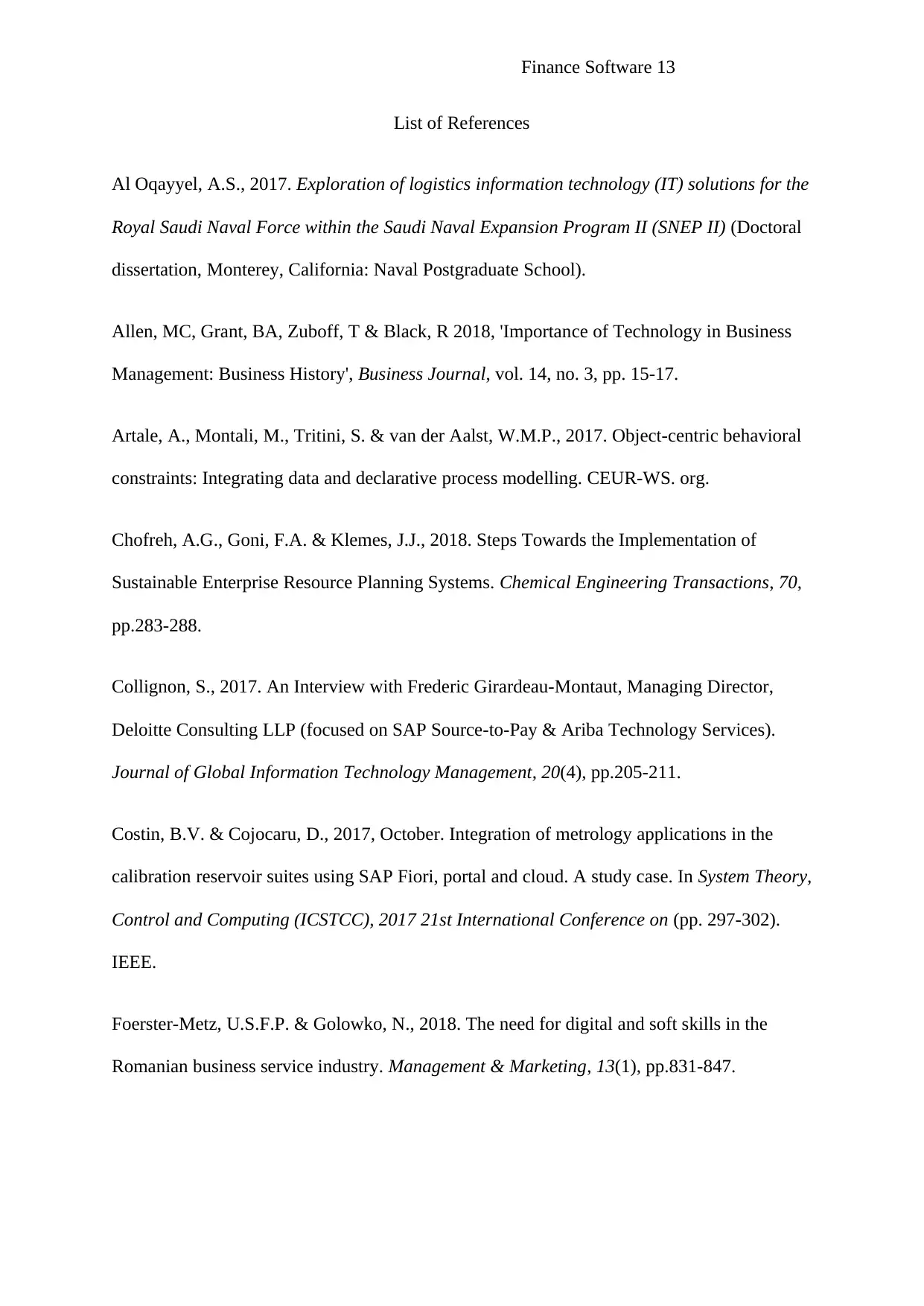
Finance Software 13
List of References
Al Oqayyel, A.S., 2017. Exploration of logistics information technology (IT) solutions for the
Royal Saudi Naval Force within the Saudi Naval Expansion Program II (SNEP II) (Doctoral
dissertation, Monterey, California: Naval Postgraduate School).
Allen, MC, Grant, BA, Zuboff, T & Black, R 2018, 'Importance of Technology in Business
Management: Business History', Business Journal, vol. 14, no. 3, pp. 15-17.
Artale, A., Montali, M., Tritini, S. & van der Aalst, W.M.P., 2017. Object-centric behavioral
constraints: Integrating data and declarative process modelling. CEUR-WS. org.
Chofreh, A.G., Goni, F.A. & Klemes, J.J., 2018. Steps Towards the Implementation of
Sustainable Enterprise Resource Planning Systems. Chemical Engineering Transactions, 70,
pp.283-288.
Collignon, S., 2017. An Interview with Frederic Girardeau-Montaut, Managing Director,
Deloitte Consulting LLP (focused on SAP Source-to-Pay & Ariba Technology Services).
Journal of Global Information Technology Management, 20(4), pp.205-211.
Costin, B.V. & Cojocaru, D., 2017, October. Integration of metrology applications in the
calibration reservoir suites using SAP Fiori, portal and cloud. A study case. In System Theory,
Control and Computing (ICSTCC), 2017 21st International Conference on (pp. 297-302).
IEEE.
Foerster-Metz, U.S.F.P. & Golowko, N., 2018. The need for digital and soft skills in the
Romanian business service industry. Management & Marketing, 13(1), pp.831-847.
List of References
Al Oqayyel, A.S., 2017. Exploration of logistics information technology (IT) solutions for the
Royal Saudi Naval Force within the Saudi Naval Expansion Program II (SNEP II) (Doctoral
dissertation, Monterey, California: Naval Postgraduate School).
Allen, MC, Grant, BA, Zuboff, T & Black, R 2018, 'Importance of Technology in Business
Management: Business History', Business Journal, vol. 14, no. 3, pp. 15-17.
Artale, A., Montali, M., Tritini, S. & van der Aalst, W.M.P., 2017. Object-centric behavioral
constraints: Integrating data and declarative process modelling. CEUR-WS. org.
Chofreh, A.G., Goni, F.A. & Klemes, J.J., 2018. Steps Towards the Implementation of
Sustainable Enterprise Resource Planning Systems. Chemical Engineering Transactions, 70,
pp.283-288.
Collignon, S., 2017. An Interview with Frederic Girardeau-Montaut, Managing Director,
Deloitte Consulting LLP (focused on SAP Source-to-Pay & Ariba Technology Services).
Journal of Global Information Technology Management, 20(4), pp.205-211.
Costin, B.V. & Cojocaru, D., 2017, October. Integration of metrology applications in the
calibration reservoir suites using SAP Fiori, portal and cloud. A study case. In System Theory,
Control and Computing (ICSTCC), 2017 21st International Conference on (pp. 297-302).
IEEE.
Foerster-Metz, U.S.F.P. & Golowko, N., 2018. The need for digital and soft skills in the
Romanian business service industry. Management & Marketing, 13(1), pp.831-847.
Paraphrase This Document
Need a fresh take? Get an instant paraphrase of this document with our AI Paraphraser
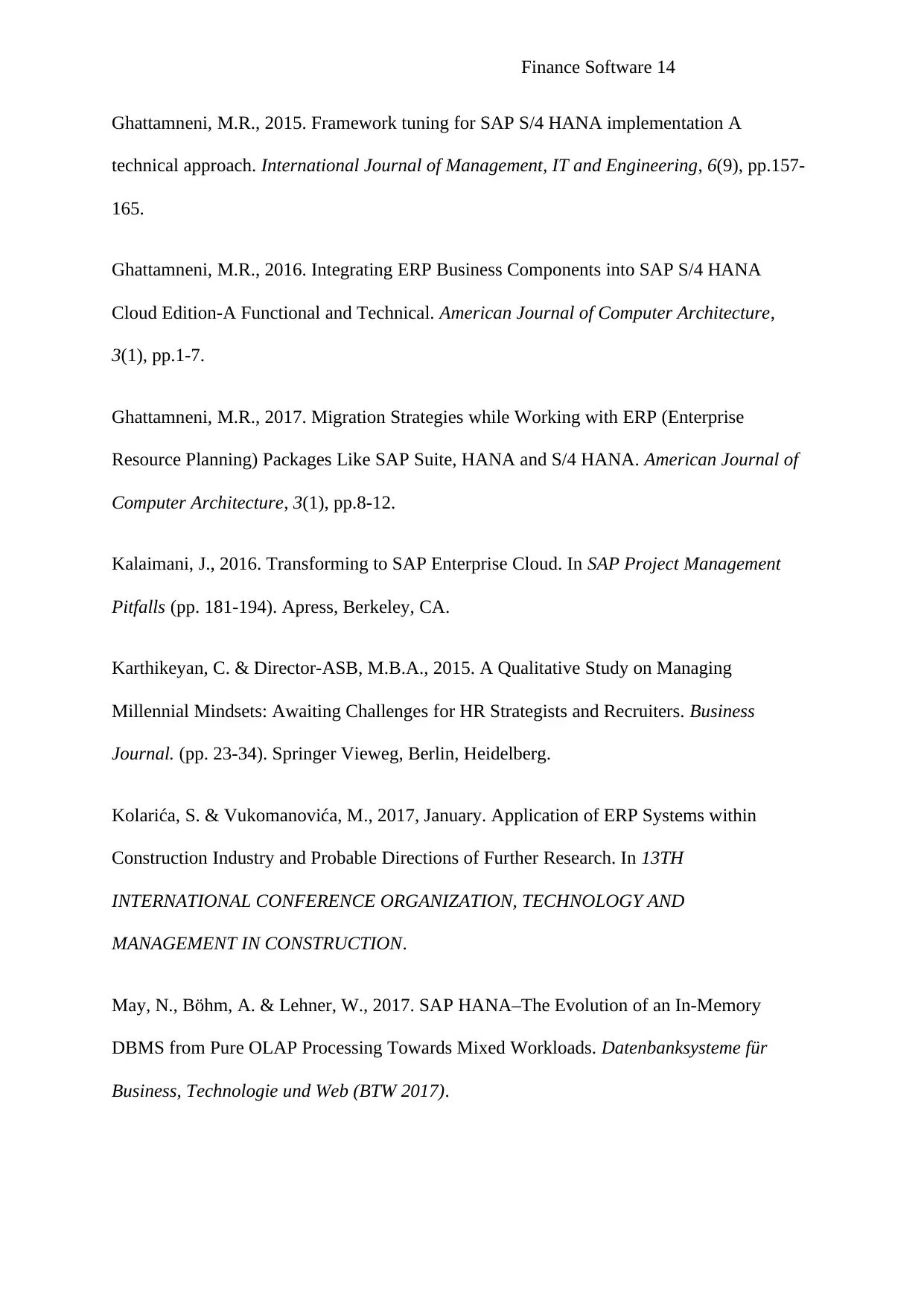
Finance Software 14
Ghattamneni, M.R., 2015. Framework tuning for SAP S/4 HANA implementation A
technical approach. International Journal of Management, IT and Engineering, 6(9), pp.157-
165.
Ghattamneni, M.R., 2016. Integrating ERP Business Components into SAP S/4 HANA
Cloud Edition-A Functional and Technical. American Journal of Computer Architecture,
3(1), pp.1-7.
Ghattamneni, M.R., 2017. Migration Strategies while Working with ERP (Enterprise
Resource Planning) Packages Like SAP Suite, HANA and S/4 HANA. American Journal of
Computer Architecture, 3(1), pp.8-12.
Kalaimani, J., 2016. Transforming to SAP Enterprise Cloud. In SAP Project Management
Pitfalls (pp. 181-194). Apress, Berkeley, CA.
Karthikeyan, C. & Director-ASB, M.B.A., 2015. A Qualitative Study on Managing
Millennial Mindsets: Awaiting Challenges for HR Strategists and Recruiters. Business
Journal. (pp. 23-34). Springer Vieweg, Berlin, Heidelberg.
Kolarića, S. & Vukomanovića, M., 2017, January. Application of ERP Systems within
Construction Industry and Probable Directions of Further Research. In 13TH
INTERNATIONAL CONFERENCE ORGANIZATION, TECHNOLOGY AND
MANAGEMENT IN CONSTRUCTION.
May, N., Böhm, A. & Lehner, W., 2017. SAP HANA–The Evolution of an In-Memory
DBMS from Pure OLAP Processing Towards Mixed Workloads. Datenbanksysteme für
Business, Technologie und Web (BTW 2017).
Ghattamneni, M.R., 2015. Framework tuning for SAP S/4 HANA implementation A
technical approach. International Journal of Management, IT and Engineering, 6(9), pp.157-
165.
Ghattamneni, M.R., 2016. Integrating ERP Business Components into SAP S/4 HANA
Cloud Edition-A Functional and Technical. American Journal of Computer Architecture,
3(1), pp.1-7.
Ghattamneni, M.R., 2017. Migration Strategies while Working with ERP (Enterprise
Resource Planning) Packages Like SAP Suite, HANA and S/4 HANA. American Journal of
Computer Architecture, 3(1), pp.8-12.
Kalaimani, J., 2016. Transforming to SAP Enterprise Cloud. In SAP Project Management
Pitfalls (pp. 181-194). Apress, Berkeley, CA.
Karthikeyan, C. & Director-ASB, M.B.A., 2015. A Qualitative Study on Managing
Millennial Mindsets: Awaiting Challenges for HR Strategists and Recruiters. Business
Journal. (pp. 23-34). Springer Vieweg, Berlin, Heidelberg.
Kolarića, S. & Vukomanovića, M., 2017, January. Application of ERP Systems within
Construction Industry and Probable Directions of Further Research. In 13TH
INTERNATIONAL CONFERENCE ORGANIZATION, TECHNOLOGY AND
MANAGEMENT IN CONSTRUCTION.
May, N., Böhm, A. & Lehner, W., 2017. SAP HANA–The Evolution of an In-Memory
DBMS from Pure OLAP Processing Towards Mixed Workloads. Datenbanksysteme für
Business, Technologie und Web (BTW 2017).
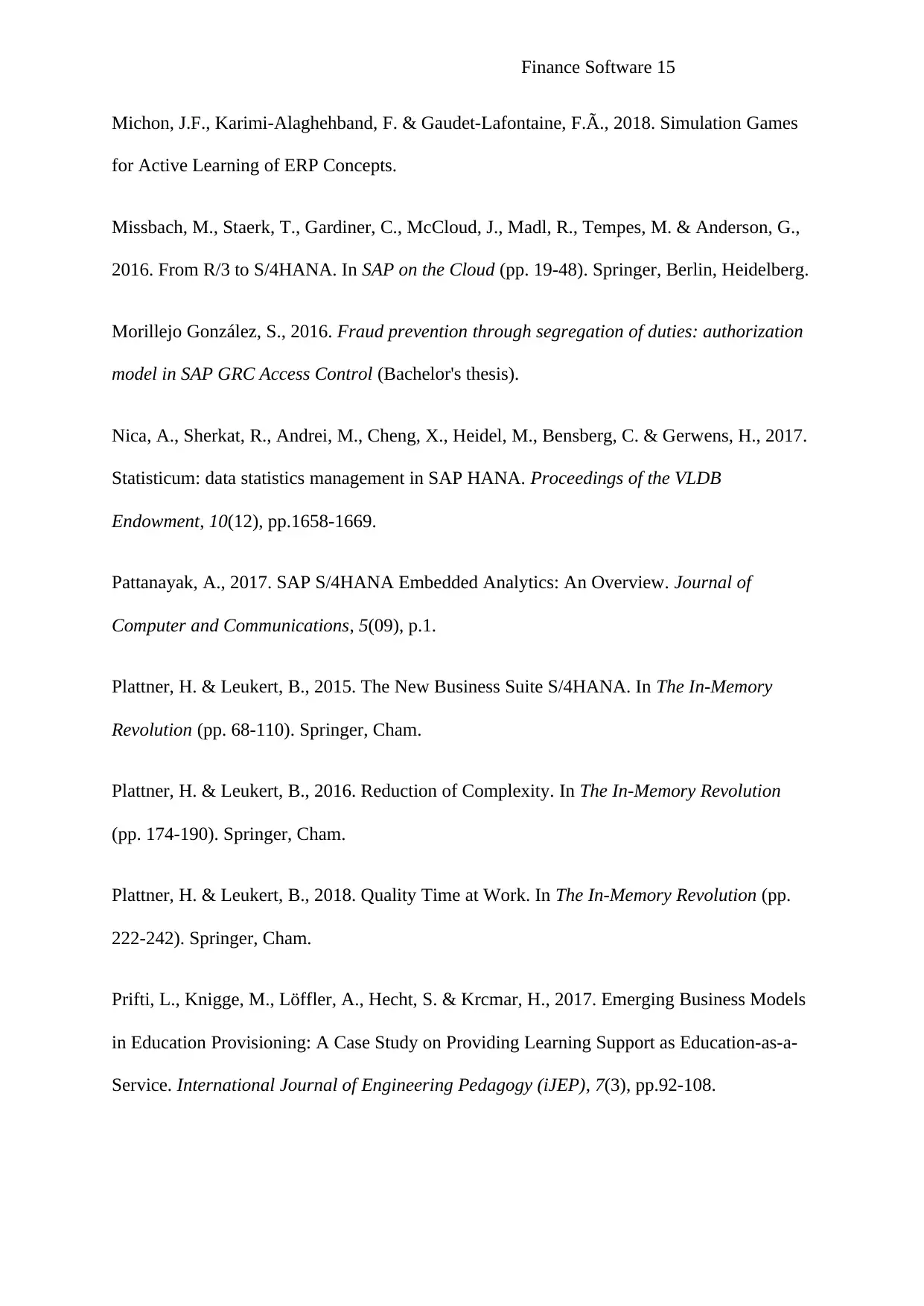
Finance Software 15
Michon, J.F., Karimi-Alaghehband, F. & Gaudet-Lafontaine, F.Ã., 2018. Simulation Games
for Active Learning of ERP Concepts.
Missbach, M., Staerk, T., Gardiner, C., McCloud, J., Madl, R., Tempes, M. & Anderson, G.,
2016. From R/3 to S/4HANA. In SAP on the Cloud (pp. 19-48). Springer, Berlin, Heidelberg.
Morillejo González, S., 2016. Fraud prevention through segregation of duties: authorization
model in SAP GRC Access Control (Bachelor's thesis).
Nica, A., Sherkat, R., Andrei, M., Cheng, X., Heidel, M., Bensberg, C. & Gerwens, H., 2017.
Statisticum: data statistics management in SAP HANA. Proceedings of the VLDB
Endowment, 10(12), pp.1658-1669.
Pattanayak, A., 2017. SAP S/4HANA Embedded Analytics: An Overview. Journal of
Computer and Communications, 5(09), p.1.
Plattner, H. & Leukert, B., 2015. The New Business Suite S/4HANA. In The In-Memory
Revolution (pp. 68-110). Springer, Cham.
Plattner, H. & Leukert, B., 2016. Reduction of Complexity. In The In-Memory Revolution
(pp. 174-190). Springer, Cham.
Plattner, H. & Leukert, B., 2018. Quality Time at Work. In The In-Memory Revolution (pp.
222-242). Springer, Cham.
Prifti, L., Knigge, M., Lö ffler, A., Hecht, S. & Krcmar, H., 2017. Emerging Business Models
in Education Provisioning: A Case Study on Providing Learning Support as Education-as-a-
Service. International Journal of Engineering Pedagogy (iJEP), 7(3), pp.92-108.
Michon, J.F., Karimi-Alaghehband, F. & Gaudet-Lafontaine, F.Ã., 2018. Simulation Games
for Active Learning of ERP Concepts.
Missbach, M., Staerk, T., Gardiner, C., McCloud, J., Madl, R., Tempes, M. & Anderson, G.,
2016. From R/3 to S/4HANA. In SAP on the Cloud (pp. 19-48). Springer, Berlin, Heidelberg.
Morillejo González, S., 2016. Fraud prevention through segregation of duties: authorization
model in SAP GRC Access Control (Bachelor's thesis).
Nica, A., Sherkat, R., Andrei, M., Cheng, X., Heidel, M., Bensberg, C. & Gerwens, H., 2017.
Statisticum: data statistics management in SAP HANA. Proceedings of the VLDB
Endowment, 10(12), pp.1658-1669.
Pattanayak, A., 2017. SAP S/4HANA Embedded Analytics: An Overview. Journal of
Computer and Communications, 5(09), p.1.
Plattner, H. & Leukert, B., 2015. The New Business Suite S/4HANA. In The In-Memory
Revolution (pp. 68-110). Springer, Cham.
Plattner, H. & Leukert, B., 2016. Reduction of Complexity. In The In-Memory Revolution
(pp. 174-190). Springer, Cham.
Plattner, H. & Leukert, B., 2018. Quality Time at Work. In The In-Memory Revolution (pp.
222-242). Springer, Cham.
Prifti, L., Knigge, M., Lö ffler, A., Hecht, S. & Krcmar, H., 2017. Emerging Business Models
in Education Provisioning: A Case Study on Providing Learning Support as Education-as-a-
Service. International Journal of Engineering Pedagogy (iJEP), 7(3), pp.92-108.
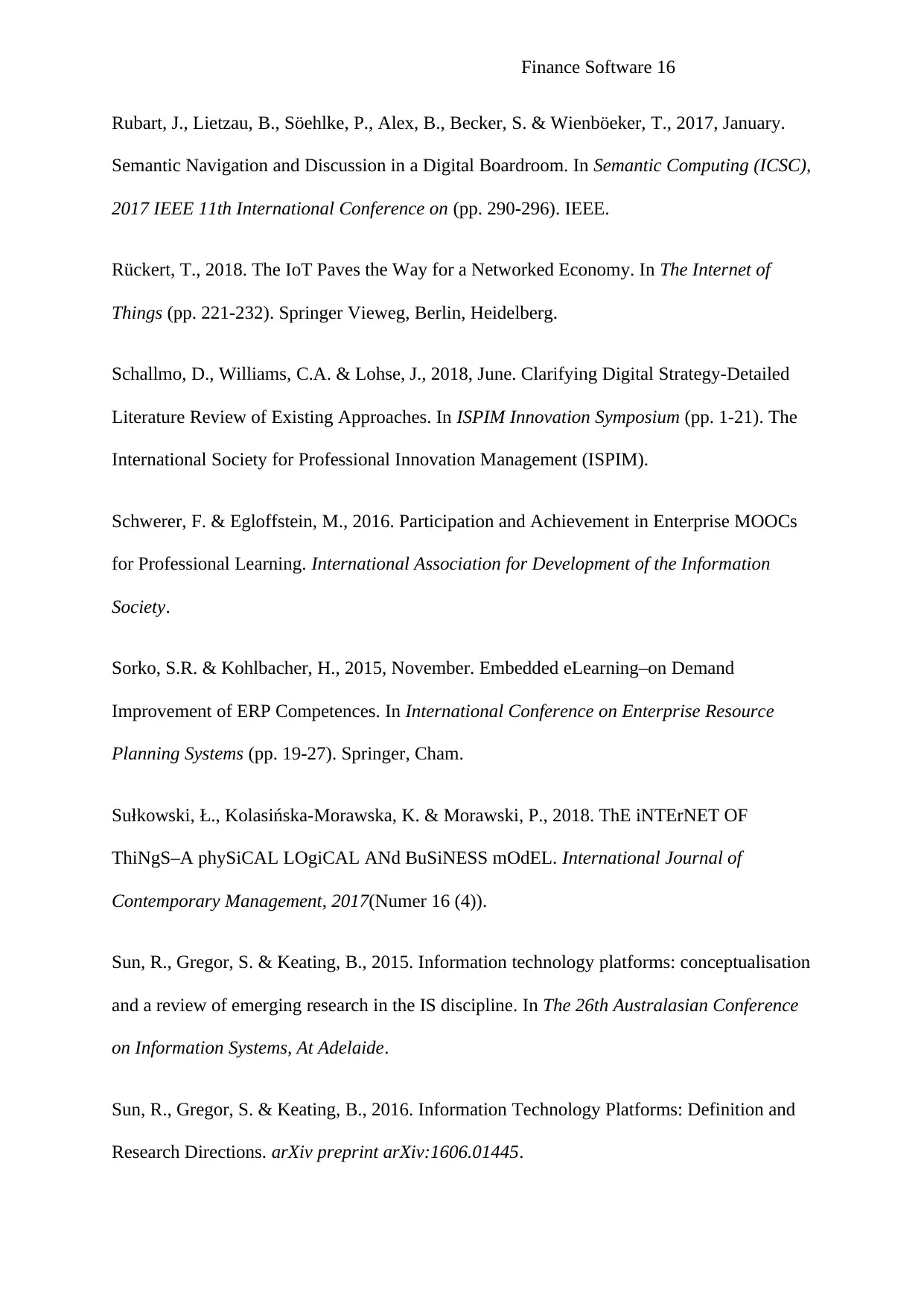
Finance Software 16
Rubart, J., Lietzau, B., Sö ehlke, P., Alex, B., Becker, S. & Wienbö eker, T., 2017, January.
Semantic Navigation and Discussion in a Digital Boardroom. In Semantic Computing (ICSC),
2017 IEEE 11th International Conference on (pp. 290-296). IEEE.
Rückert, T., 2018. The IoT Paves the Way for a Networked Economy. In The Internet of
Things (pp. 221-232). Springer Vieweg, Berlin, Heidelberg.
Schallmo, D., Williams, C.A. & Lohse, J., 2018, June. Clarifying Digital Strategy-Detailed
Literature Review of Existing Approaches. In ISPIM Innovation Symposium (pp. 1-21). The
International Society for Professional Innovation Management (ISPIM).
Schwerer, F. & Egloffstein, M., 2016. Participation and Achievement in Enterprise MOOCs
for Professional Learning. International Association for Development of the Information
Society.
Sorko, S.R. & Kohlbacher, H., 2015, November. Embedded eLearning–on Demand
Improvement of ERP Competences. In International Conference on Enterprise Resource
Planning Systems (pp. 19-27). Springer, Cham.
Sułkowski, Ł., Kolasińska-Morawska, K. & Morawski, P., 2018. ThE iNTErNET OF
ThiNgS–A phySiCAL LOgiCAL ANd BuSiNESS mOdEL. International Journal of
Contemporary Management, 2017(Numer 16 (4)).
Sun, R., Gregor, S. & Keating, B., 2015. Information technology platforms: conceptualisation
and a review of emerging research in the IS discipline. In The 26th Australasian Conference
on Information Systems, At Adelaide.
Sun, R., Gregor, S. & Keating, B., 2016. Information Technology Platforms: Definition and
Research Directions. arXiv preprint arXiv:1606.01445.
Rubart, J., Lietzau, B., Sö ehlke, P., Alex, B., Becker, S. & Wienbö eker, T., 2017, January.
Semantic Navigation and Discussion in a Digital Boardroom. In Semantic Computing (ICSC),
2017 IEEE 11th International Conference on (pp. 290-296). IEEE.
Rückert, T., 2018. The IoT Paves the Way for a Networked Economy. In The Internet of
Things (pp. 221-232). Springer Vieweg, Berlin, Heidelberg.
Schallmo, D., Williams, C.A. & Lohse, J., 2018, June. Clarifying Digital Strategy-Detailed
Literature Review of Existing Approaches. In ISPIM Innovation Symposium (pp. 1-21). The
International Society for Professional Innovation Management (ISPIM).
Schwerer, F. & Egloffstein, M., 2016. Participation and Achievement in Enterprise MOOCs
for Professional Learning. International Association for Development of the Information
Society.
Sorko, S.R. & Kohlbacher, H., 2015, November. Embedded eLearning–on Demand
Improvement of ERP Competences. In International Conference on Enterprise Resource
Planning Systems (pp. 19-27). Springer, Cham.
Sułkowski, Ł., Kolasińska-Morawska, K. & Morawski, P., 2018. ThE iNTErNET OF
ThiNgS–A phySiCAL LOgiCAL ANd BuSiNESS mOdEL. International Journal of
Contemporary Management, 2017(Numer 16 (4)).
Sun, R., Gregor, S. & Keating, B., 2015. Information technology platforms: conceptualisation
and a review of emerging research in the IS discipline. In The 26th Australasian Conference
on Information Systems, At Adelaide.
Sun, R., Gregor, S. & Keating, B., 2016. Information Technology Platforms: Definition and
Research Directions. arXiv preprint arXiv:1606.01445.
Secure Best Marks with AI Grader
Need help grading? Try our AI Grader for instant feedback on your assignments.
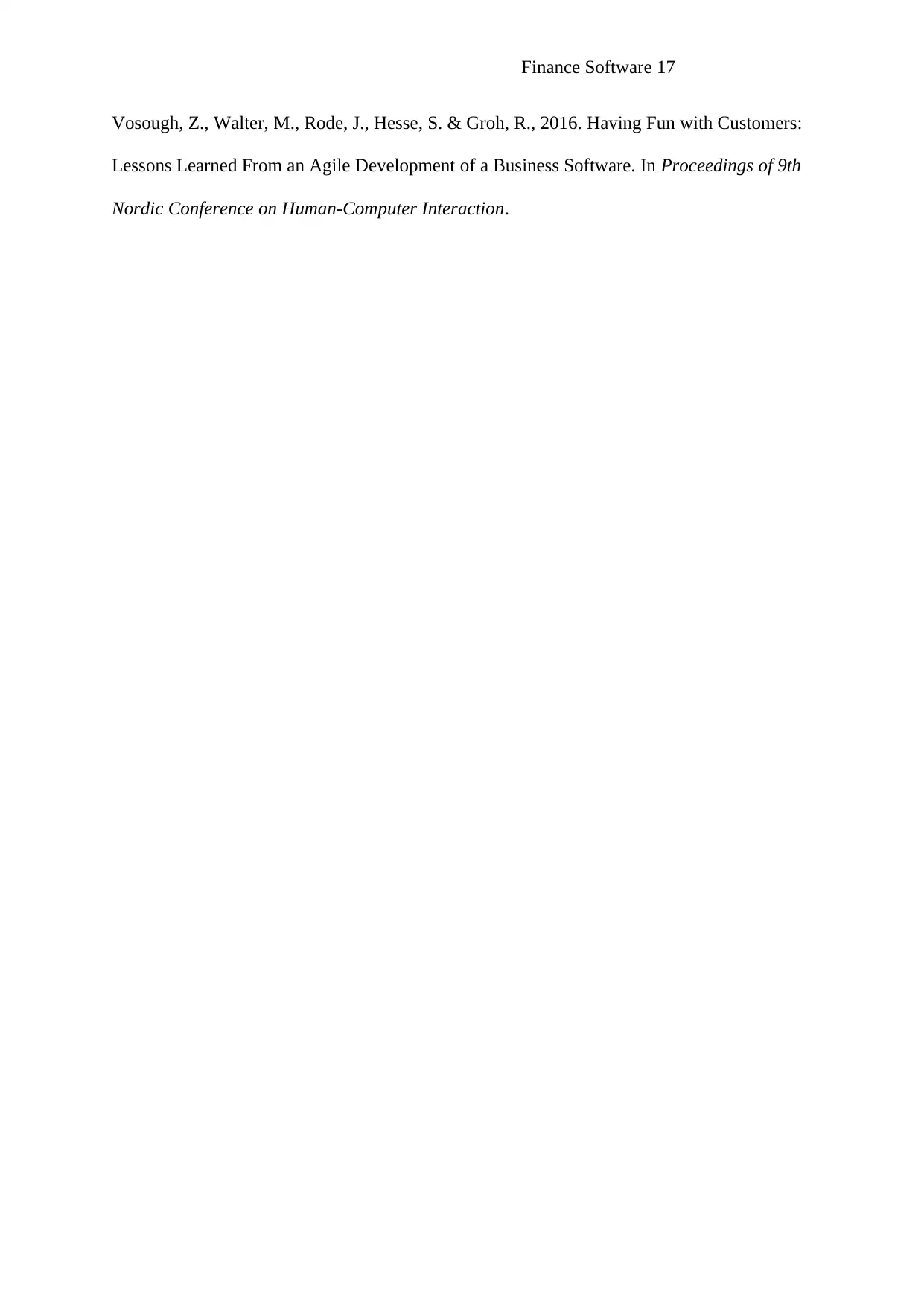
Finance Software 17
Vosough, Z., Walter, M., Rode, J., Hesse, S. & Groh, R., 2016. Having Fun with Customers:
Lessons Learned From an Agile Development of a Business Software. In Proceedings of 9th
Nordic Conference on Human-Computer Interaction.
Vosough, Z., Walter, M., Rode, J., Hesse, S. & Groh, R., 2016. Having Fun with Customers:
Lessons Learned From an Agile Development of a Business Software. In Proceedings of 9th
Nordic Conference on Human-Computer Interaction.
1 out of 17
Related Documents
Your All-in-One AI-Powered Toolkit for Academic Success.
+13062052269
info@desklib.com
Available 24*7 on WhatsApp / Email
![[object Object]](/_next/static/media/star-bottom.7253800d.svg)
Unlock your academic potential
© 2024 | Zucol Services PVT LTD | All rights reserved.





